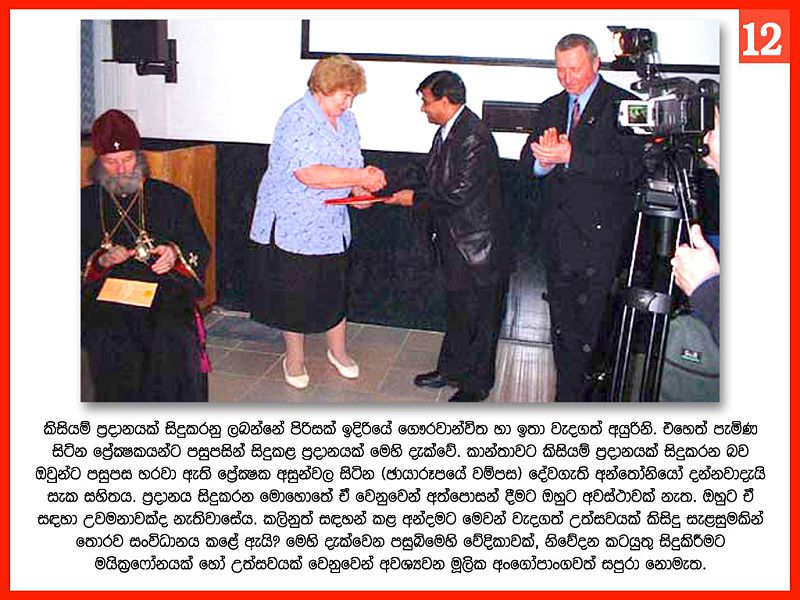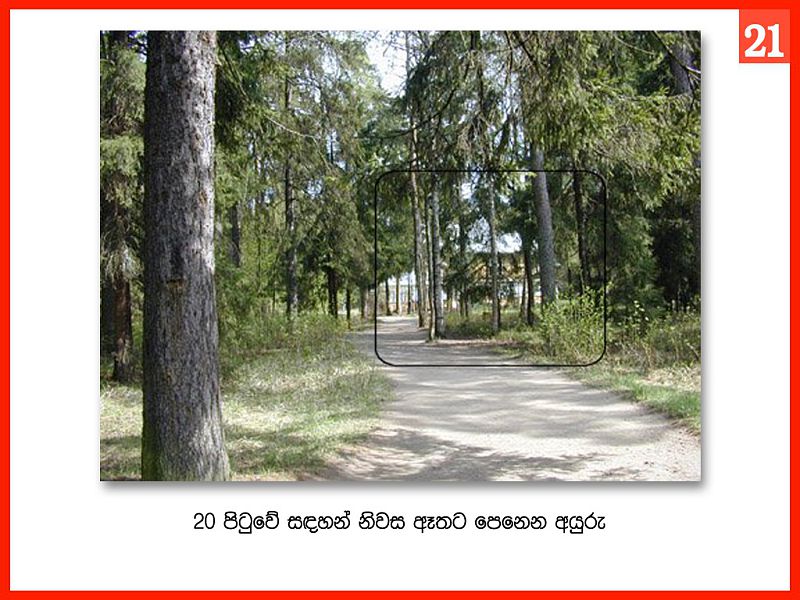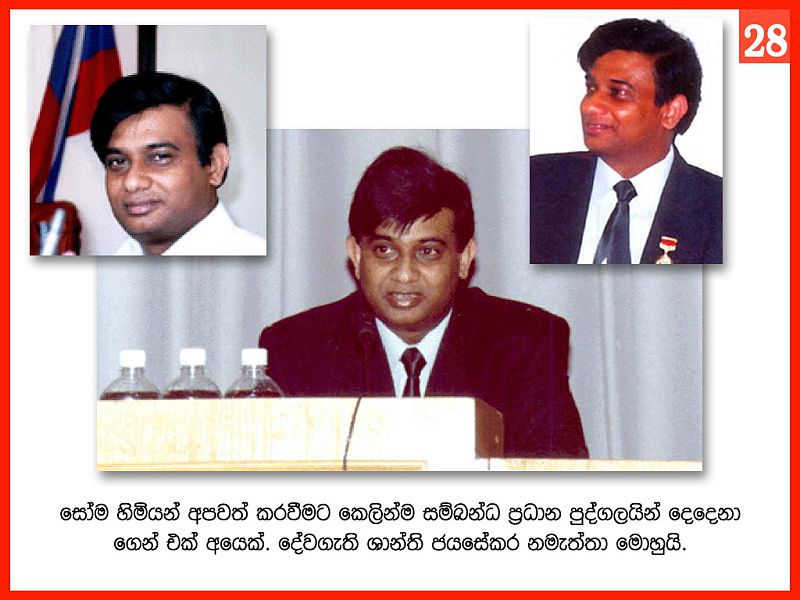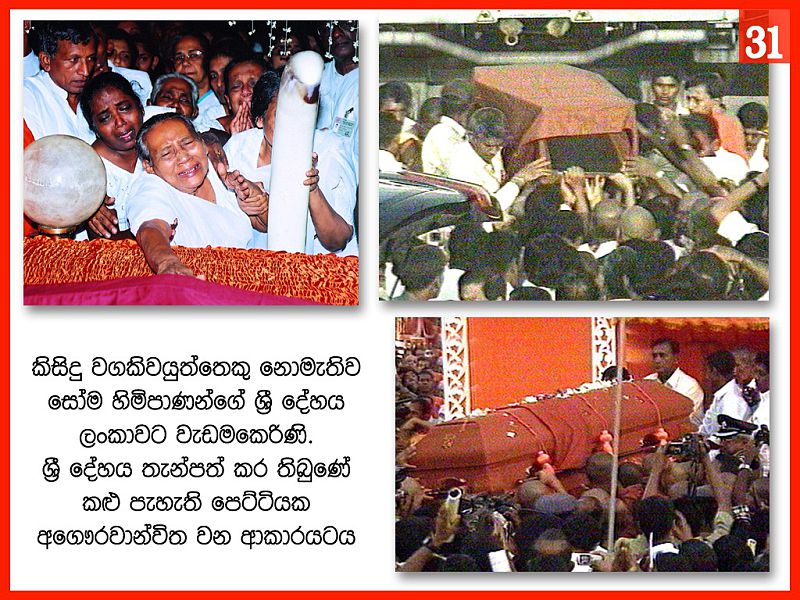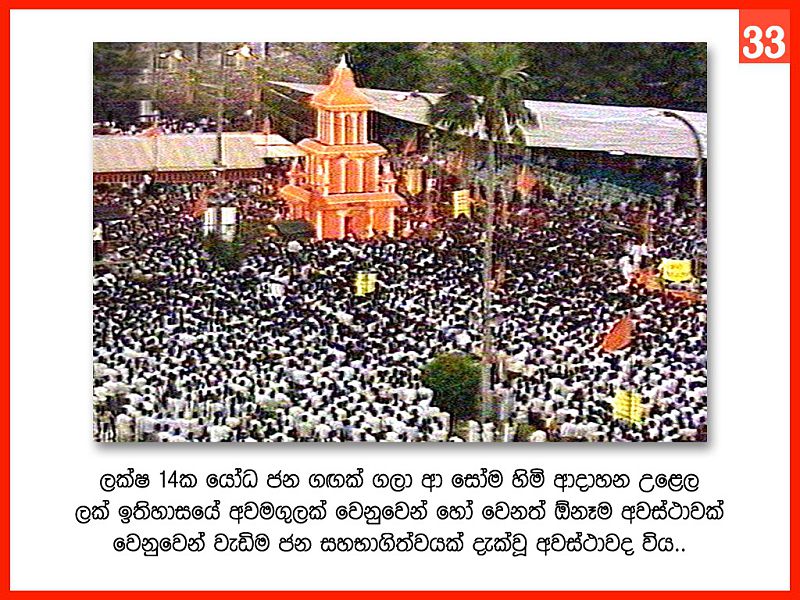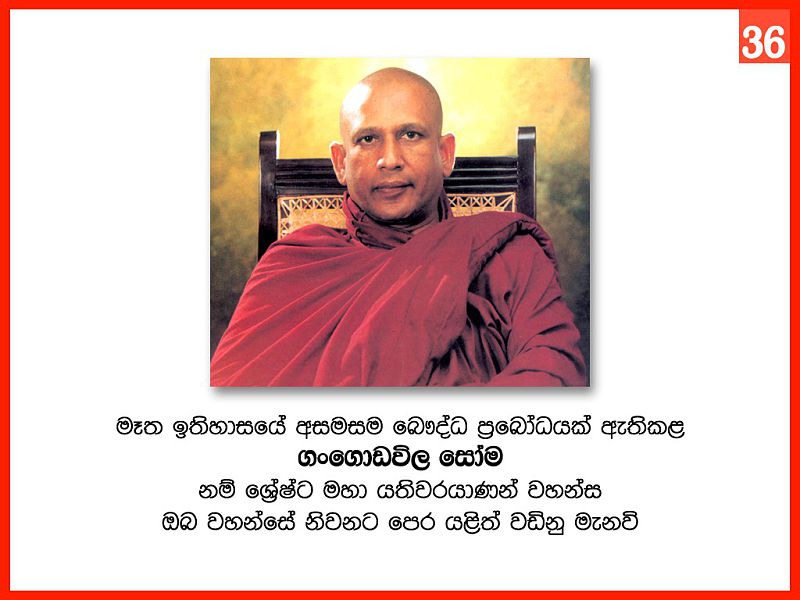මුල්ලේරියාව සංග්රාමය( 4 වන පරිච්ඡේදය. “සටන”) The Battle
මුල්ලේරියාව සංග්රාමය( 4 වන පරිච්ඡේදය. “සටන”)
The Battle ————————————————————
පෙර ප්රවේශයන් හිදී සටනේ අවි ආයුධ, උපක්රම සහ සේනා සංවිධානය ගැන සාකච්ඡා කලෙමු. මෙවර සෘජුවම අප සටනට ප්රවේශ වන අතර “සංග්රාම සැලසුම “(battle plan ) ඊට සමාන්තරව විමසන්නේ සටනේ සිද්ධි වින්යාසය සමග යමින් වඩා පහසු තේරුම් ගැනීමක් සදහාය. මෙය මුල්ලේරියාව සටන ගැන සර්ව සම්පූර්ණ සටහනක් නොවේ. එහෙත් එය ගැන මූලික පදනම් සටහනක් වෙයි. පාඨකයන් මෙය කියවීමට පෙර ධාරණය කර ගත යුතු කරුණූ කීපයකි. අ) යුධයක උපක්රම ( tactics )සහ උපායමාර්ගය (strategy )අතර වෙනස සහ සහසම්බන්ධනය. ආ) මුල්ලේරියාව වෙල් යායේදී සිදු වූ සටන ඒ ආශ්රිතව සහ සමස්ත මෙහෙයුම තුල වූ යුධ ක්රියාදාමය තුල එක් සටනකි. ඇ) විවිධ මූලාශ්ර සහ තර්කවේද මත අපට ලැබුන දත්ත සහ බලකොටු ස්ථාන දැනට විවිධය. එහෙත් මිලිටරි කෝණයෙන් මුල්ලේරියාවේ ස්ථානීයව වූ සටන අපට පැහැදිලිය.මුල්ලේරියාව සටන ආරම්භ වන්නේ පරංගි හෙවත් ප්රතිකාලුන් ඇතුලු කෝට්ටේ සේනාව සීතාවක දක්වා ආක්රමණය කිරීමට උත්සාහ ගත් අවස්ථාවකයමායාදුන්නේ සහ ටිකිරි කුමරු ගේ සීතාවක පාලනය තිබෙන තාක් සිංහලය හෙවත් ඔවුන්ට Ceilão යටත් කරගැනීමට නොහැකි වනවා පමණක් නොව තම පැවැත්මත් නැති වනු ඇතැයි තේරුම් ගත් පරංගිහූ සීතාවක ආක්රමණය කිරීමට තීරණය කරන ලද්දේ. ” ආරක්ෂාවට හොදම දෙය පහරදීම යි”යන ප්රත්යය ට අනුවය . එය ප්රහාරක ප්රවේශයකි (an offensive approach ). එවකට මෙරට පෘතුගීසි කපිතන් ජෙනරල් වූ ජෝර්ජ් දි මෙනේසස් ගේ සැලසුමකි.මුල්ලේරියාව සටන සිදුවූ දිනය 1562 අගෝස්තු 23 හෝ ඊට ට පසු දිනයක් ලෙස පිලිගැනේ. එහෙත් රාජාවලියට අනුව 1581 වසරේ ද ,පෘතුගීසි වාර්තා අනුව 1559 මැයි මසට පසු එම වසරේම බවත් සටහන් වේ. උක්ත ප්රදේශය නිරිත දිග මෝසම් සමයේ දැඩි වර්ෂාපතනය ට හසුවන නිසා මෙය නිරිතදිග මෝසමට පසු අගෝස්තු වැනි කැලණි ගංගාවේ ජල ප්රවාහය සැඩ පහරින් අඩු කාලයක සිදු වූ බව පැහැදිලිය. එවන් නිගමනයකට මා එන්නේ මන්දැයි ඉදිරියට ඔබට වැටහෙනු ඇත.
මෙහෙයුම ——————–
කොලඹ කොටුවෙන් ඇරඹෙන මෙහෙයුම කෝට්ටේ සහ ලස්කිරිඤඤ බලඇණි සමග එකතු වෙමින් වරාගොඩ ඔස්සේ නැගෙනහිර දෙසට ඉදිරියට ඇදෙයි. මේ හමුදාව කැලණි ගංගාව ට අනුරූපව ගග ඉහත්තාව ට ඇදෙන්නේ මෙහෙයුමේ පලවන පියවර ලෙස මාපිටිගම බලකොටුව යටත් කරගෙන,දෙවැනුව එතැන් සිට සීතාවක මධ්යයේ ඇති ගුරුබැවුල හෙවත් පසුව හංවැල්ල වූ බලකොටුව ඉලක්ක කරගනිමින් බව පෙනේ. දෙවන අදියර සදහා පරංගි සේනාව ගග දිගේ සහ ගොඩබිමින් මෙහෙය විය යුතු නම් මාපිටිගමෙන් එන ප්රතිරෝධය නිෂ්ක්රීය කල යුතුය. ඉනික්බිති ව දෙවන පියවර අසාර්ථක වුවත් පලවෙනි පියවරේදී මාපිටිගම අල්ලා ගත හොත් අනාගතයේදී එය සිතාවක ට නැවත නැවතත් පහර දීමට ඉදිරි පෙල බලකොටුවක් සහ මෙහෙයුම් මධ්යස්ථානයක් ලෙස භාවිතා කල හැකිය. (A forward Base and a launching pad for future offensives ) . මෙය උපායමාර්ගිකව නිරවද්ය සැලසුමකි. මේ සදහා පරංගි හමුදාව කැලණි ගග දිගේ යාත්රා වලින්ද, ගගේ දකුණු ඉවුරට සමාන්තරව ගොඩ බිමින්ද මෙහෙය විය. මෙය කෙටි කලක් තුල වේගයෙන් කල යුතු මෙහෙයුමක් ලෙස සැලසුම් කරන්නට ඇත. කෙසේ මුත් මාපිටිගම ඉලක්කය ට ලගා වීමට පෙර අඹතලේ සහ කඩුවෙල ආදී සීතාවක ප්රධාන බලකොටු කීපයක් සහ මාඒදණ්ඩ වැනි මුරපොලවල් අතට ගත යුතු විය.පරංගී සේනාව නිත්ය සෙබලුන් සහ Casados සහ Topazes ස්වේච්ඡා සෙබලුන් 1000 -1600. අතර වූ බව පෙනේ. ලස්කිරිඤඤ සේනාව 2000 – 3000 අතර වූ බව පෙනේ. එමෙන් කාපිරි ජාවක සහ පරංගිකරණය වූ ඉන්දියානු වැනි වහලුන් හෝ කුලී භටයින් ද ඇතුලත්ව 4000 පමණ හමුදාවක් සමස්ත මෙහෙයුමට එක්ව සිටියහ. මෙතසස් ට අනුව 7000 ක් පමණ විය.පරංගි සේනාව ජෝර්ජ් දි මෙනේසස් යටතේ වූ අතර කපිතන් බල්තසාර් ගේඩ්ස් දි සූසා, දියෝගු දි මෙලෝ,දොන් ෆ්රැන්සිස්කො දි මෙලෝ, සිමාඕ දි බ්රීටෝ,අයිරස් දි සල්දානා ,සිමන් දි මෙලෝ ,නූනෝ පෙරෙයිරා, ලසාදෝ අන්තෝනියෝ,ඩයස් දි ලොම්බා, අන්දෝ දි ෆොන්සේකා,මැනුඑලෝ ලොරෙන්සෝ සහ ගැස්පාර්රෝ ගුවේටස් ආදී සෙනෙවියන් ද ඒ ඒ සේනාංක බාරව සිටියෝය. කෝට්ටේ සේනාව දොන් ජුවන් ධර්මපාල රජුගේ ඥාති සහ සෙනෙවි සෙබ්බපෙරුමාල් හෙවත් තම්මිට සූරිය බණ්ඩාර යටතේ විය.මීට පෙර අවස්ථාවකදී මායාදුන්නේ ට එරෙහිව පෘතුගීසි + කෝට්ටේ ප්රහාරයෙන් සීතාවක අල්ලා ගත් අතර මායාදුන්නේ ට කලුගගේ දකුණු ඉවුරේ වූ බටුගෙදර තම මුලස්ථානය කරගෙන වසර 3 ක් සිටීමට සිදු විය. එවැනිම ප්රහාරයක් කිරීම පරංගීන් ගේ අදහස වන්නට ඇත. මෝදර සිට දියත් කල බෝට්ටු භටයින්, සහ ද්රව්ය (logistics ) පටවා ගෙන රක්ගහවත්ත මුර පොල පසුකරමින් ඉදිරියට එන ලද අතර මෙම සමහරක් යාත්රා සන්නාහ සන්නද්ධ වූ අතර ඒවායේ Berco සැහැල්ලු ක්ෂේත්ර කාලතුවක්කු සවිකර තිබුණි. රට තුලට ගංගා ඔස්සේ ගමන් ගත් මෙවන් යාත්රා හබල් ගෑම මගින් සහ සමහර අවස්ථාවල රුවල් මගින් ක්රියාත්මක විය.මෙහෙයුමේ මුල් අවස්ථාවේ සීතාවක දේශසීමාව උල්ලංඝනය කර පරංගි හමුදාව පහර දෙමින් වේගයෙන් ඉදිරියට එන අතර සීතාවක භටයෝ සීතාවක තුල ට පසු බසිති.
පලවෙනි සටන ————————-
පසුව දා පරංගී ඉලක්කය වන්නේ සීතාවක සහ පරංගි කෝට්ටේ (කොලඹ) අතර දේශසීමාවේ වූ ක්ෂේත්ර බලකා මුලස්ථානයකි. මෙය දැව කදන් පවුරක් යුතු stockade ආකාරයේ බලකොටුවක් බව පෙනේ .අලුයම ජාමයේම පරංගීන් මෙයට හදිසියේ raid එකක් කර එහි සිටී සීතාවක සෙබලුන් 300 මරා දමයි . (Sitawakan were taken by the surprise ) ඉතිරි සෙබලුන් හේවාගම දෙසට පසු බසී. ඉනික්බිතිව සිදු වෙමින් යන්නේ ඉදිරියට එන පරංගීන් සහ පසුබසින සීතාවක භටයින් අතර ජංගම යුද්ධයකි. (Mobile war )සීතාවක සේනාවක් මෙහෙයුම වලකනු පිණිස හේවාගම ආශ්රිතව අඹතලේ බලකොටුව ඇතුලු ආරක්ෂක තීරූවක සිටින බවට පරංගීන් ට තොරතුරු ලැබෙන අතර උදෑසනම ඔවුනට පහර දීම සඳහා රැයෙහිම එදෙසට සේනාව ගමනේ යොදවයි. ඉදිරියට ඇදෙන පරංගීන් ගැන රාජසිංහ ට තොරතුරු ලැබෙන අතර වික්රමසිංහ මුදලි යටතේ සේනාවක් හේවාගම අඹතලේ රැකවල් ලා සිටින භටයන්ගේ සහයට යවයි. එහෙත් පරංගි ගිනි බලය සහ උපක්රම හමුවේ එම හේවාගම ආරක්ෂක තීරුව (defence line ) හෝ බලකොටුව බිදී යන අතර සීතාවක භටයෝ 200 ක් පමණ මිය යති. මෙහිදී වික්රමසිංහ ඒකනායක මුදලි තුවාල ලබයි. (අඹතලේ බලකොටුව සහ ආරක්ෂක තීරුවේ සීතාවක භටයින් 4000 ක පමණ පිරිසක් සිටී බව සමහර සටහන් වල දැක්වේ. )මේ අන්තර්කාලය රාජසිංහ රජුට තම සේනාවන් රැස් කර ගැනීමට සහ පරංගීන් පරාජය කිරීමට අවශ්ය සැලසුමකට අවස්ථාව සපයයි. එහිදි රාජසිංහයෝ ” තම සතුරා තමාට සටන් කිරීමට වඩා සුදුසු භූමියකට එන තෙක් සිට පහර දී පරාජය කිරීම “යන උපාය මාර්ගය භාවිතා කිරීමට තීරණය කල බව පෙනේ..
සීතාවක රාජසිංහයන්ගේ යුධ විශේෂඥ බව එයයි.
දෙවන හෙවත් මහා සටන ——————————————
හේවාගම -මුල්ලේරියාව යුධ ක්ෂේත්රය ට එන තෙක් භූමියේ අණ දීම සීතාවක සේනාධිපති වික්රමසිංහ මුදලි යටතේ විය. (මුදලි හෙවත් Mudlier according to Europeans. යනු මහනුවර රාජධානියේ දිසාවේ තනතුරට සමාන වේ ). ඒ තීරණාත්මක අවස්ථාවේ සිට සීතාවක රාජසිංහ අණදීම බාර ගනී. මුල්ලේරියාව ක්ෂේත්රයේදී සීතාවක හමුදාව, විශේෂ බලකා පලිහක්කාරයන් 1000 ට වැඩි පිරිසක් ඇතුලුව වික්රමසිංහ විජේසුන්දර සහ ජයසුන්දර සේනාංකයන්ද , ස්වේච්ඡා සිවිල් භටයින් ද (people’s militia ) සහිතව 3000 – 4000 අතර පිරිසක් වන්නට ඇත. පසුපසින් පහර දුන් (a decoy tactic ) පිරිසද පලිහක්කාරයෝ සේනාංකයට අයත් වූ බලඝණයක්ද, එසේ නැත්නම් වෙනම ඉලංගම් විශේෂ බලකායක් ද යන්න පැහැදිලි නැතත් එය කොරතොට කුරුප්පු ආරච්චිගේ විශේෂ සෙබල කණ්ඩායම ක් (a special unit )බව පැහැදිලිය . එසේම ප්රධාන සටන මුල්ලේරියාවේ සිදු වුවත් එයට ආශ්රිත මෙහෙයුම් සමස්තය තුල සක්රීය සෙබලුන් 6000 කට ආසන්න පිරිසක් සිටියා විය හැකිය. මන්ද, මුල්ලේරියාවේදී සීතාවක හමුදාව ආරච්චි වරුන් 18 දෙනෙකුද ඇතුළත් අණ දෙන නිලධාරීන් 40 දෙනෙකු යටතේ විය .සියලු සේනාංක තුල ගොනුව සිටී ස්වේච්ඡා සිවිල් භටයින් මුල්ලේරියාව අවට කඩුවෙල, කොරතොට හෝකන්දර ආදී ගම්වල ජනයා විය. මුල්ලේරියාව ජයග්රහණයට පසු “අභීතව හේවා කම් කල හෙයින් ” මේ ගම්මාන සියල්ල හේවාගම් කෝරලය ලෙස රාජසිංහයෝ නම් කරන ලදි. මෙම සේනාව ආරච්චිවරුන් යටතේ විය. එමෙන්ම සමස්ථ සේනාව තුල සබරගමුව, හත්, තුන් සහ හතර කෝරල, සහ ඌව ආදී සෙසු දිසා වල සොල්දාදුවන් සිටිය බව පෙනී යයි.. රාජසිංහයෝ ආකර්ෂණීය නායකයෙක් විය (charismatic leader ) .තම සෙබලුන් සමගම සිටීම, තමනුත් යුධ බිමටම ගොස් සටන් කිරීම, සොල්දාදුවන්ට සහ නිලධාරීන්ට අවශ්ය සම්පත් ආම්පන්න අප්රමාදව ලබා දීම සහ දක්ෂයන් ට තෑගි බෝග ඇතුලු තනතුරු දීම නොවලහා කරන ලදි. දෙවනුව යුද්ධයක් රජෙකුට තනියම කල හැක්කක් නොව එය නිලධාරීන් සහ සොල්දාදුවන් ගේද දක්ෂතාව සහ කැපවීමකි. එහෙත් යුද්ධයක් දිග් විජය කල හැක්කේ බලය සහ උපායමාර්ගය, ධූරාවලියේ ඉහලම සිටින තනි නායකයෙකු වටා ධ්රැවීයකරණය වුවහොත් පමණකි. හැනිබල්, ස්පාටකස් සහ නැපෝලියන් ට සේ තමාව කිසි විටක අතැර නොයන සහ විනයෙන්ද මොරාලයෙන්ද අත්යන්ත හමුදාවක් රාජසිංහයෝ වටා විය. ඉහත කී පරිදි සීතාවක ඉදිරි පෙල බලකොටු යටත් කරගත් පරංගි සහ කොට්ටේ සේනාවෝ මුල්ලේරියා වෙල ආශ්රිතව කදවුරු බැද ගෙන පසු දින සටනට ලැස්ති වෙති. නමුත්, උදෑසන හිරු එලිය වැටෙන්නට හෝරාවකට පෙර අදුර සහ වෙල පුරා වැතිර ඇති මීදුම ආවරණයට ගෙන් රාජසිංහ සමග මැද කණ්ඩායම ඔවුන්ට ප්රබල ප්රහාරය ක් කරමින් සටනට මුල පුරයි. රාජාවලිය මෙසේ පවසයි. .” වික්රමසිංහ මුදලින් බිදී ගිය හැටි රාජසිංහ රජු දැකලා වම – දකුණු පලිහක්කාරයන් හා දෙබාගේ ඇතුන් හා කොරතොට ආරච්චිවරුන් ලගට කැදවා හෝකන්දර රදා -දොලහ හේවායින් ගෙන්වා ඉලංගම් වල පලිහක්කාරයන් දහසකුත් දී පස්ස පොරතුවට පැන කොටන් ද ඇරලා රාජසිංහ පෙරමුණ ඉස්සර පාරෙන් ගොස් මුල්ලේරියා වෙල මැද හිටිනා කල ප්රතිකාල් සේනාවට යුද්ධයට පැන්නාහ.” එනම් වික්රමසිංහ මුදලි යටතේ ඉතිරිව සිටි හමුදා පිරිසට පලිහක්කාරයන් සහ ඇතුන් ද දී පරංගී සේනාවේ පසුපස භාගය ට යවා, ගස් කදන් වලින් හිරකර පරංගීන් ට පසු බැසීමට හෝ flanking කිරීමට ඇති වාසිය නැති කර දැමීමේ flanking maneuver එකකි. මේ සේනාවට හෝකන්දර ගම් වලින් සිවිල් සේනාව (militiamen )ද යවා ඇත. ඉන්පසු සිදුවූ දෙය එහිම . “පස්ස පොරත්තුවෙන් ගිය හමුදාවක් ඇවිත් පැනලා යුද්ධ කරන විට ජයසුන්දර බාගෙන් වීර හස්ති කියන ඇතා කොඩියක් ගතීය, වීරසුන්දර බාගෙන් එරාවණයා පලිසකුත් දම්වැලකුත් ගතීය. රාජසිංහ අසු පිටට නැගී මහා සේනාව පස්සට වෙන්ඩ නෑර ප්රතිකාලුන් මැදට පැනලා.. පලිහක්කාරයෝ ප්රතිකානොන් ට ඇතුන්ගේ වල්ගා වල එල්ලී කෙටුවාහ. තුවක්කු වලින් ගසා ප්රතිකානෝ පලිහක්කාරයන් මැරුවාහ.පස්ස පොරත්තුවෙන් ගිය හමුදාවක් ඇවිත් පැනලා යුද්ධ කරන විට. ..”ලෙස හදුන්වන කොරතොට කුරුප්පු ආරච්චිගේ කණ්ඩායම ඉරු නැගෙන්නට පෙර කලුවරේම සතුරා කදවුරු ලා සිටින භූමියට පසු පසින් කා වැදුනාද ?එසේ නැත්නම් අලුයම බිම් මට්ටමින් ඇති මීදුමට මුවා වී කා වැදුනාද ?එම කාවැදීම (infiltration ) වගුරු ඔස්සේ කලාද එසේ නැත්නම් ගග හරහා amphibious ලෙස කරාද යන්න නොදනිමු. කෙසේ හෝ ඔවුන් කරන කොමාන්ඩෝ ආකාරයේ හදිසි ප්රහාරය පරංගීන් මහත් අපහසුතාවයට පත් කරන අතර තුර රාජසිංහ රජු ප්රමුඛ යුධ ඇතුන් සහ පලිහක්කාරයෝ හදිසි ප්රහාරයක් මගින් සතුරු ඉදිරි පෙල කඩාගෙන පරංගි සේනාව මැදට පහර දීමයි.ඉහත විස්තරය අනුව පරංගීන් ට පලවෙනි (සහ සමහර විටදෙවැනි) වෙඩි වැට තබා නැවත තුවක්කු පුරවා ගැනීමටත් පෙර සීතාවක පෙරමුණු බල ඇණිය සතුරාට ආසන්නව උරෙනුර ගැටෙන සටනක් (melee ) කල බවයි. පරංගීන් කොතෙක් තුෂ්ණිභූතව සහ අසංවිධානාත්මක වී ගියේද යත් රාජාවලිය ට අමතරව ක්වේරෝස් සහ දී කූතෝ ගේ සටහන් වලින්ද පෙනෙයි . .ඉදිරිපස පරංගි පෙරමුණ කඩාගෙන සතුරු සේනාංකය සිටි භූමියට මෙහෙය වූ යුධ ඇතුන් බලඝණයේ සංයුතිය ගැන පැහැදිලි සටහනක් දැනට නැතත් සිංහල සේනාවල පුරාණ සම්ප්රදායක් වූ 1: 6: 80 භාවිතා කලේද හෝ වෙනත් සංයුතියක් භාවිතා කලේද යන්න ට වඩා මෙහිදී යුධ ඇතුන් , අශ්වාරෝහකයෝ සහ පලිහක්කාරයෝ ඒකාබද්ධ කර විශේෂ සංයුතිය ක් භාවිතා කල බව උපකල්පනය කල හැක . එය නූතනයේ Armered personal carrier (APC) භාවිතා කර සතුරු පෙරමුණක් බිදීම (breaching ) මගින් සෙසු සේනාවට සතුරා වෙතට වේගවත් විහිදුමක් ( rapid deployment )කිරීමට සමානය. ඉන්පසු රාජාවලිය මෙසේ කියයි. “රාජසිංහ රජු අසුට නැගි විහිදුවා සේනාව වටකර දුවමින් රණ යුධ ගිනි කෙල කොටන විට දුරුතු මස මිහිදුම් මෙන් වෙඩි දුම් පටලාගෙන සිටින සද , මුල්ලේරියා වෙල මැද ලේ වතුර කොට ප්රතිකාල් සේනාවට අඩියක් වත් පස්සට යන්ඩ නෑර කොටා එක්දහස් හයසීයක් ප්රතිකානුන් හා කෝට්ටේ සේනාවෙන් කීප දෙනෙකුත් කොටා වැටුනාහ..”!රාජසිංහ “ගෝපාල ” නම් තම යුධ අසු පිට අසිපත ලෙලවමින් සටන් භූමිය තුලම ගැවසෙන්නේ ස්වකීය සේනාවට පසු බැසීමට නොදී ඔවුන් මෙහෙයවමින් සහ උද්යෝගිමත් කරමිනි. මේ අතර ඔහු සතුරන්ට කෙටීම කලත් එක තැනක නැවතී සටන් කිරීමට නොහැකි වන්නේ සේනාවිධායක ලෙස සටන් බිමේ තුනින් තැනට යාමට සහ අණ දීමට සිදු වන බැවිනි. යුධ කෙලිය අතර එය කෙතරම් අනතුරුදායක දැයි අමුතුවෙන් කිව යුතු නැත.
දක්ෂ අශ්වාරෝහකයෙකු වු එතුමන් රණ පිටිය තුල අසු මෙහෙයවන්නේ විදුලිය මෙන් යයි වංශ කතා කරුවෝ සහ ජනප්රවාදයේ පවසති.රාජසිංහ ට වම් පසින් වූ සහායක සේනාව (ජයසුන්දර හෝ වීරසුන්දර රෙජිමේන්තුව ) ,ඒතෙක් බටහිර දෙසින් හූමිය අල්ලා ගෙන සිටින (hold on ) වික්රමසිංහ මුදලි ගේ සේනාව දෙසට යවන්නේ flanking maneuver මගින් සතුරු සේනාවට එදෙසින්ද පසු බැසීමට නොහැකි වන පරිදි සිර කරමිනි. මෙය සේනා අතර සන්ධාරණය සහ සතුරු ප්රතිප්රහාරයක් ප්රේරණයට තීරණාත්මක විය. ( link up and buffer )දැන් දකුණින් රාජසිංහ සහ ජයසුන්දර හෝ වීරසුන්දර සේනාංකයන්ද , බටහිරින් වික්රමසිංහ සේනාංකය සහ එකතු වූ සේනාංකය+ පලිහක්කාරයන් ද, උතුරින් කැලණි ගංගාවෙන්ද මායිම් වූ සීමිත බිම් කඩක පරංගි සේනාව සිර වී සිටි. කිසිදු දෙසකට ඔවුන්ට පසු බැසීමට නොහැක. අන්තිමයා දක්වා සටන් කරන සමූලඝාතනය වීමේ උගුලට ඔවුන් හසුවී ඇත. (Enviloped and driven into a so- called total annihilation scenario ) මේ සටනේදී සීතාවක හමුදාව ද ගිනි අවි භාවිතා කර තිබේ. “සීතාවක යුධ උපාය වූයේ සතුරා ගේ භූමියටම පැන ඉතා සුලු වේලාවක් තුල සතුරා විනාශ කිරීමය “..අද මෙන් ස්වයංක්රීය ගිනි අවි හෝ පතුරම් අවි නොතිබුණු එකල එවන් ලග ලගම කරන වේගවත් ප්රහාරයකදී කැපෙන සහ අනින අවි භාවිතා කිරීමට සිදුවේ. (A close quarters battle ). එවකට වූ matchlock කොටන තුවක්කු නැවත නැවත පුරවා භාවිතයට වෙලා ගතවේ. එහෙත් ක්ෂේත්ර පහර දීම් සදහා ස්ථානීයව හෝ ජංගමව කොඩිතුවක්කු සහ අත් තුවක්කු භාවිත කල බව පෙනේ. රාජාවලියේ “මීදුම වැනි වෙඩි දුම”යන්නෙන් දෙපාර්ශ්වය විසින් බහුලව ගිනි අවි භාවිතා කර ඇති බල ප්රත්යක්ෂ වෙයි. සීතාවක හමුදාව ට කොටුවූ පරංගීන් ට සහයට වෙඩි ප්රහාර (support fire ) සහ සැපයුම් (logistics ) කැලණි ගගේ තිබූ පෘතුගීසි යාත්රා වලින් ලැබුණද රාජසිංහ ඒවාටද පහර දුනි. කඩු පොරෝ පහරින් කැපී සහ ආකිබස් සහ කාලතුවක්කු ප්රහාරවලට ලක්ව මියෙන හෝ තුවාල ලබන දෙපාර්ශ්වයේ ම පිරිස අතර අති බහුතරය පරංගීන් විය. ලේ වැගිරීම කෙතරම් දරුණු වූවාද යත් මුල්ලේරියාව වගුරු බීමේ වතුර ලෙයින් රතු පාටට හැරුනු බව පැවසේ. එය සැබෑවක් යයි අමුතුවෙන් පැවසීය යුත්තක් නොවේ. “යුධ ඇතුන් භාවිතා කිරීම නිසා තමන් පැරදුන බව ” කූතෝ සහ ක්වේරෝස් සටහන් කරයි. බලාපොරොත්තු සුන් වූ පරංගින් කොඩි ගස් වලින් පවා ඇතුන්ගේ නලලට ඇන්න බවත් ඔවුන් සටහන් කරති. මුල්ලේරියාවේ දී රාජසිංහයන්ට ජයග්රහණය ලැබීමට යුධ ඇතුන් වැදගත් විය.සටනේ පරාජය සමග තම්මිට සූරිය බණ්ඩාර තම කෝට්ටේ සේනාව සමග පලා යති. සටන අවසානයේ පරංගීන් කීප දෙනෙකු (ඩයස් සහ පිරිස) අතැර දමා තිබූ පොකුරු මුණිස්සම් කාලතුවක්කුවක් පත්තු කර බේරී පැනගොස් තිබේ. තවත් තැනක සටහන් වන්නේ ගගේ නවතා තිබූ බෝට්ටු වලට නැගී පණ බේරාගෙන යාමට ඉතිරි වූ පරංගි සහ කෝට්ටේ පිරිසට සහ තුවාලකරුවන් ට සීතාවක සේනාව මානුෂිකව ඉඩ දුන් බවයි. මෙම සටනේදී පරංගි නිලධාරීන් බොහෝ දෙනෙකු මිය යයි. මෙනේසස් පණ බේරාගෙන තිබේ. රාජාවලියට අනුව පරංගීන්ම පමණක් 1600 කී. කොට්ටේ සහ ලස්කිරිඤඤයන් ද ඇතුලුව 2000 විය හැක. සීතාවක සොල්දාදුවන් කොතෙක් මිය ගියාද යන්න ගැන දැනට කිසිදු මූලාශ්රයක් නැති සෙයකි.
ජයග්රහණය ———————–
යුධ ජයග්රහණය ඉහලින් සැමරුණි. පරංගීන් කදවුරු ලා සිටි තැනක සීතාවක සේනාවෝ තම කොඩි සිටවූ අතර එය කොඩිගහවත්ත විය. අද කොටිකාවත්ත ලෙස හදුන්වන්නේ එම ප්රදේශයයි. සීතාවක බල සීමාව කොලඹට 12 km ආසන්නයේ ඇති බියගම දක්වා ගෙන එන්නේ බියගම ආශ්රිතව බලකොටුව තව ශක්තිමත් කරමිනි. . මුල්ලේරියාව මිලිටරි ජයග්රහණයක් පමණක් නොව දේශපාලන ජයග්රහණයක් ද විය. මුල්ලේරියාවේ බිහිසුණු පරාජයෙන් පසු පරංගීන් 1565 දී කොට්ටේ අතහැර දමා කොලඹට පසු බසින අතර මිලිටරි සහ දේශපාලන බලය වර්ධනය කරගන්නා සීතාවක තම එතිහාසික මහා යුධ මෙහෙයුම පරංගී හදවත තුලට ම යවන යවුල් පහරක් සේ වර්ෂ 1587 ජුනි සිට 1588 පෙබරවාරි අතර කොලඹ කොටුව ට එල්ල කරන්නේ ලංකා භූමියෙන් පරංගි උවදුර සදහටම අතුගා දැමීමට පෙරමුණට එමිනි.. පරංගී, කෝට්ටේ සහ මහනුවර එකට එකතු වී පහර දුන්නත් ඒ සියල්ලම එක මිටකට ගෙන පරාජය කිරීමට තරම් රාජසිංහයෝ ගේ මිලිටරි විශේෂඥ බව අනභිභවනීය විය.අමාවක රැයක කැලණි මිටියාවතේ සරණ ඔබ, ගගට බර කුඹුක් සෙවනක ගෝපාල අසුට දිය පොවමින් සිටින දිදුලන සන්නාහයෙන් සැරසුන ප්රෝඞ පුරුෂයෙකු දුටුව හොත් සටන ගැන ඔහුගෙන් අසන්න.
කීර්ති හේවාගොඩ 25 -05- 2020
ආශ්රිත ග්රන්ථ. (Bibliography )
1- .Fatalida de Historias”.Ribeiro joao (1685). The historic tragedy of the island of Ceilao. Translated by P.E. Pieris.
2- ලංකාවේ පෘතුගීසි යුගය. පෝල් පීරිස්. පරිවර්තනය අභය හේවාවසම්. 20083- රාජාවලිය. ඒ ටී සුරවීර. 1997.
4- සීතාවක සටන- පරණවිතාන රෝහිණී. 1999.5- සැවුල් සන්දේශය. අලගියවන්න මුකවෙටි.
6- කොන්ස්තන්තීනු හටන.
7- සීතාවක රාජධානියේ උන්නතියේ ද අවනතතියේද සමහර අංශ පිළිබඳව විමර්ශනය ක්. .රිසීමන් අමරසිංහ. ( 1998)
8- Kandy fights the Portuguese. C.Gaston Perera.
9- Historia da India. Decada xiii .Antonio Bocarro.
10- මන්දාරම් පුවත. සංස්කරණය. ලබුගම ලංකානන්ද හිමි.
11- The Temporal and Spiritual Conquest of Ceylon. Queiros Fernan. Also the works of Wimalananda Thennakoon, Fr. Perniola, P E P Deraniyagala were used in this article.
සැලකිය යුතුයි. .–චිත්ර සහ අනන්ය සටහන් නෛතිකව කතෘ අයිතිය ට යටත්ය. සටහන share කිරීම ගැටලුවක් නැත. Free to share in social media as the original post . However, for other uses, the keynotes and sketches are strictly protected by copyright
උපුටාගත්තේ >> Keerthi.Hewagoda ගේ මුහුණු පොතෙන්ය. https://www.facebook.com/Keerthi.Hewagoda
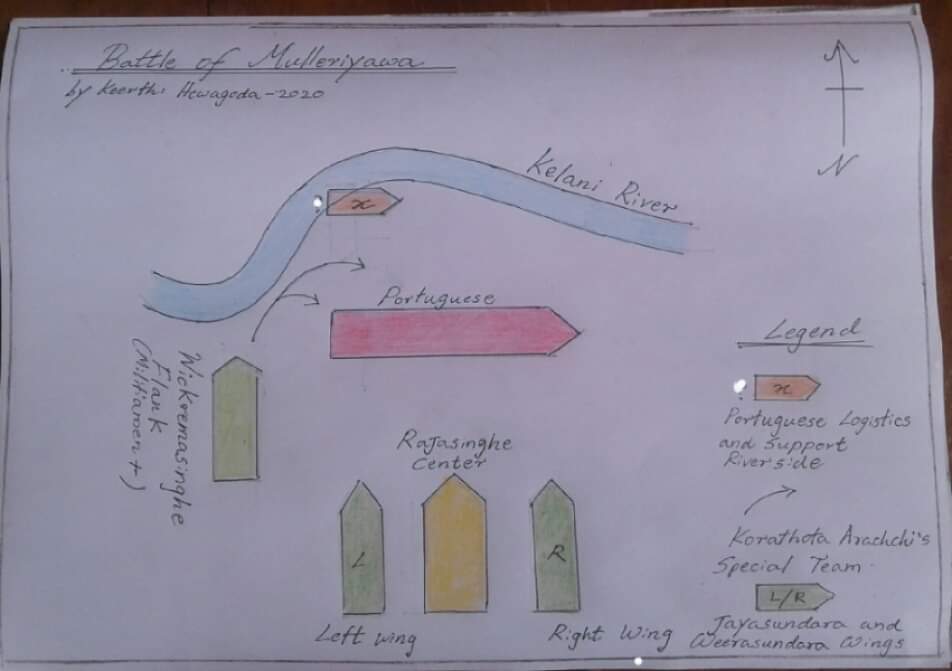



ඉන්දියාව කරන දෙමල ආක්රමණය
මෙම හෙළ දෙරණට ඉතිහාසයේ නොයෙකුත් ආක්රමණ හින්දු දේශයෙන් සිදු වුව ද, ඒ කිසි දු ආක්රමණයක් වර්තමානයේ මෙ රටේ ජීවත් වන්නා වූ තමිල් ජනයා ගේ මුතුන් මිත්තන් විසින් කරන ලද ය යි සනාථ කිරීමට කිසි දු සාක්ෂියක් නොමැත. එවන් ආක්රමණවලින් මෙ රටේ ජනාවාස ඇති වූ බවට ද කිසි ම සාධකයක් නොමැති අතර, අවශේෂ ආක්රමනික ජනයා වී නම් ඔවුන් සිංහල බෞද්ධ සංස්කෘතිය තුළට අනුගතව සිංහලයන් බවට පත් වුනි. එසේ කිරීමට අප ගේ රජ දරුවන් වග බලාගත් බව ගජබා රජතුමා ගේ 12,000ක සොලීන් මෙ රටට ගෙනවිත් සිංහලයන් බවට පත් කිරීමේ ක්රියාකාරකම්වලින් පැහැදිලි වේ.
ද
වර්ෂ 1505 දී පෘතුගීසින් මෙ රටට පැමිණෙන විට මෙ රටේ ජීවත්ව ඇත්තේ ජන කොට්ටාශ දෙකක් පමණක් බවට ඔවුන් සිංහලයන් හා වැදි ජනයා බවත් මුලාශ්ර මඟින් නිශ්චිත වී ඇත. එසේ ම, මෙහි සත්යතාව පෘතුගීසින් සමඟ ඇති වූ ගැටුම් පිළිබඳ වූ ඉතිහාස මුලාශ්රවලින් ද සනාථ කෙරේ. පෘතුගීසින්, ලන්දේසින් හා ඉංගිරිසින් මලබාර් ජනයා මෙරටට ආක්රමණිකයන් ගේ වහලුන් ලෙස රැගෙන එන්නට විය. එහෙත් බ්රිතාන්ය යුගය ඇරඹෙන තෙක් මේ මලබාරයන් හුදෙක් තාවකාලිකව රැ කියාවේ නියුතුව සංචාරක ශ්රමිකයන් පමණකි. මලබාර් ජනයා, 1818 නිදහස් අරගලයෙන් පසු මුලිකව යාපනයේත් 1848 නිදහස් අරගලයෙන් පසු නැඟෙනහිර ඇතුළු අනෙකුත් පෙදෙස්වලත් ස්ථිර ලෙස පදිංචි කර ජනාවාස පිහිටවන ලද්දේ නීති විරෝධී ඉංගිරිසින් ගේ පාලනය විසිනි.1818 කැරැල්ලෙන් පසු විනාශ කොට හා දිය කොට හැරි සිංහල ප්රභූ පාලක පංතියෙන් ඇති වූ පරිපාලන හිඩැස පිරවීම පිණිස ඉංගිරිසින් විසින් යාපනයේ පදිංචි කරවන ලද මලබාර් ජනයා අතරන් ඉංග්රීසි උගත් ප්රභූ පංතියක් බිහිකොට ඔවුන් මෙ රටේ රාජ්ය සේවයට හා පාලන තන්ත්රයට ඇතුළත් කරීමට කටයුතු යෙදවිය. මෙසේ උසස් පැලැන්තිය බිහි කිරීමේදී ලන්දේසි මුහුදුබඩ පෙදෙස් පාලන කාලයේ ඔවුන්ට යටත්ව තිබූ ප්රදේශවල මුදලිවරු ලෙස සේවය කළ ලන්දේසීන්ගේ වරප්රසාද ලත් බලබාර් ජනයාට මූලිකත්වය ලබාදුන්හ. ප්රථම මලබරයා පාලන තන්ත්රයට ගෙන එනු ලබන්නේ 1832 ව්යවස්ථාදායක සභාවට දෙමළ බස කථා කරන ජනයාට නියෝජිතයකු ඔවුන් අතරින් පත් කිරීමෙන් ය. ක්රමයෙන් ඉංගිරිසි අධ්යාපනය හරහා ලංකාවේ සිවිල් සේවයේ ආධිපත්ය ලබා ගන්නා මලබාරයන් 1907 ව්යවස්ථාදායක සභාවට පොන්නම්බලන් අරුනාචලම් පත් වීමත් සමඟම සිංහලයට එරෙහි ව මෙ රටේ පාලන බලය අල්ලා ගැනීමේ සිහිනය ඇති කරගන්නා ලදී.
ලංකාවේ පාලන බලය අල්ලා ගැනීමේ සිහිනයට සමගාමිව 20 වන සියවස මුල් භාගය වන විට ඉන්දියාවේ තමිල්නාඩුවේ වෙනම ‘ ස්වාධින තමිල් රාජ්යයක්’ සඳහා අඩිතාලම යොදන ලදී. ඉතා තීව්රර ලෙස වර්ධනය කරන ලද මෙම සංකල්පය හා එහි ක්රියාකාරිත්වය ජවහල්ලාල් නේරු පාලනය විසින් විනාශ කිරීමට යෙදින. මේ ක්රියාදාමයන්ට සමගාමි ව ලංකාවේ පාලන බලය අල්ලා ගැනීමට උත්සහ කරන ලද තමිල් අන්තවාදීන් ගේ සිහිනය මැනිං ප්රතිසංස්කරණ, ඩොනමෝර් ප්රතිසංස්කරණ හා සර්වජන ඡන්ද බලය පිරිනැමීම ආදිය හේතු කොට ක්රමානුකූලව බිඳ වැටීමකට ලක් විය. මේ බිඳ වැටීමත් සමඟ ම තම පාලන සිහිනයේ අභිප්රාය සපුරා ගැනීම පිණිස තව දුරටත් ඉදිරියට යෑමට මාර්ගයක් නොමැති වූ ලංකාවේ තමිල් බෙදුම්වාදීන් අසරණ තත්වයකට පත්වු හ. මීට සමගාමී ව, ස්වාධින තමිල් රාජ්යයක් ඉන්දියාවේ ඇති කිරීම සඳහා කරගෙන යන ලද අරගලය ද බිඳ වැටීම හේතු කොට ඉන්දියාවේ තමිල්නාඩුවේ ස්වාධින තමිල් රාජ්ය සංකල්පය ද ප්රතික්ෂේප වී අසරණ තත්වයකට ඉන්දියාවේ තමිල් අන්තවාදීද පත් විය. ලංකාවේ පාලන බලය අල්ලා ගැනීමට මාන බලමින් සිටි තමිල් බෙදුම්වාදීන්ට නව මාර්ගයක් විවර කර දෙන්නේ ඉන්දියාවේ බිඳ වැටුණු ස්වාධින තමිල් රාජ්ය සංකල්පය, ඉන්දියානු තමිල් යන්ගේ සැලසුමකට අනුව ලංකාවේ තමිල් බෙදුම්වාදීන් හා එක්ව ‘තමිල් ඊළම’ නමින් 1976 වඩ්ඩකොඩේ සම්මේලනය හරහා ලංකාවේ ස්ථාපිත කිරීම හරහා ය. මෙ සේ ඉන්දියාව බෙදීමට ඉපදී පසුව ලංකාවේ රෝපණය කරන ලද බෙදුම්වාදී සංකල්පය අවසානයේ වසර 23 අධික විනාශකාරි ත්රස්තවාදයකට රට ඇද දමනු ලැබීය.
1978 ජයවර්ධන පාලනය ආරම්භවීමත් සමඟ ම විවෘත ආර්ථිකය සඳහා රට විවර කිරීමත්, ජයවර්ධන පාලනයේ අමෙරිකානු, ඊශ්රායල් හා බටහිර ගැති විදේශ ප්රතිපත්තිය හේතුවෙන්, ආර්ථික වශයෙන්ම මෙන්ම ආරක්ෂක වශයෙනුත් තම රටට ලංකාව දැඩි තර්ජනයක් ලෙස ඉන්දියාව දක්නට විය. එසේ ම, එවකට ඉන්දියානු අගමැතිනි ඉන්දිරා ගාන්ධි ගේ හා සිරිමාවෝ බණ්ඩාරනායක ගේ දැඩි මිත්රත්වය හා ජයවර්ධන පාලනය විසින් බණ්ඩාරනායක මැතිනිය ගේ ප්රජා අයිතිය අහෝසි කිරීම වැනි වූ පෞද්ගලික කරුණුත් කිහිපයක්ම හේතුකොට ඉන්දිරා ගාන්ධි ආණ්ඩුව ලංකාවේ තමිල් බෙදුම්වාදය පෝෂණය කිරීමටත්, ශක්තිමත් ලෙස වර්ධනය වීමටත් යුධ අවි පුහුණුව, මිල මුදල් පහසුකම් ඇතුළු සෑම ආකාරයක ම සහයෝගයන් ලබා දුන්නාය. අවසානයේ රජිව් ගාන්ධි ආණ්ඩුව විසින් 1980 දසකයේ දී ජාත්යන්තර ගුවන් නීති, ජාත්යන්තර සම්මුතින් ද උල්ලංඝනය කරමින් ලංකා ආණ්ඩුවට නීති විරෝධි හා සදාචාර විරෝධී බලපෑම් කරමින්, කිසි දු ඔප්පු කොට සහතික කොට පෙන්වා දෙනු ලැබූ පදනමකින් තොර ව උතුරු නැගෙනහිර සම්ප්රදායික තමිල් නිජබිම් බවට පිළිගන්නා ලෙස ජයවර්ධන ජනාධිපතිවරයාට අනිසි බලපෑම් කරමින් ඒ වගන්තිය ඇතුළුව තමිල් බෙදුම්වාදී ත්රස්තවාදීන්හට පුර්ණ ලෙස ම වාසි වන ඉන්දු ලංකා ගිවිසුම බලහත්කාරයෙන් අත්සන් කරන ලදී. උතුරේ තමිල් බෙදුම්වාදීන් පවසා සිටින්නේ තමන් ශ්රී ලංකික තමිලයන් ලෙස අනන්ය බව හා ඔවුන් ඉන්දියාවේ වෙසෙන තමිල් ජනයා, ලංකාවේ වතුකරයේ හා අනෙකුත් පෙදෙස්වල වෙසෙන ඉන්දියානු සම්භවයක් සහිත තමිල් ජනයා ගෙන් වෙන් වූ අනන්ය ශ්රී ලංකික සම්භවයක් සහිත පිරිසක් ලෙස ය. එහෙත්, ලංකාවේ තමිල් බෙදුම්වාදී ප්රශ්නය අරභයා ඉන්දියාව හා ලංකාව අතර ඉන්දු ලංකා ගිවිසුම අත්සන් කිරීමෙන් තහවුරු වන්නේ මෙ රටේ වෙසෙන තමිල් ජනයා යනු තම රටට අයත් ජන කොටසක් ලෙස ඉන්දියාව පිළිගන්නා බව. (එය එසේ ම බව මුලාශ්ර සහිත ව පසුව ඔප්පු කර පෙන්වා සිටිමු). එසේ නොමැති නම්, ලංකාවේ අභ්යන්තර ප්රශ්නයකට ඉන්දියාව ලංකාව හා ගිවිසුමක් අත්සන් කිරීමට කිසිදු අවශ්යතාවක් හෝ අදාළත්වයක් නොමැත.
චීනයේ ගොඩනැගෙන ආර්ථික හා යුධ අභියෝගය හමුවේ ඇමෙරිකාව ඇතුළු ඔවුන්ගේ මිත්ර පාර්ශවික රටවල් ලංකාවේ බෙදුම්වාදයට අත පෙවීම
මුලදී ඉන්දියාව තමනට අභියෝගයක් ලෙස දුටු ඇමෙරිකාව, කලාපය තුළ තම කටයුතු මෙහෙයවීමට ඉරණවිල ඇමෙරිකන් හඬ ගුවන් විදුලිය ස්ථාපිත කරන්නට යෙදින. එවකට ජයවර්ධන ආණ්ඩුව විසින් ගනු ලැබූ මෙවැනි අදුරදර්ශී තීරණ ඉන්දියාවේ ආරක්ෂාවට ලංකාව තර්ජනයක් ලෙස සැලකීමටත්, ඉන්දියාවේ හොඳ හිත පලුදු වීමටත් හේතු විය.
1978 වසරේ චීනයේ ආර්ථික ප්රතිසංස්කරණ සිදු කිරීමෙන් පසු 20 වන සියවස අවසානයේ වන විට චීනයේ ඉහල ආර්ථික දියුණුව තමන්ට ඇති සැබෑ ම තර්ජනයක් බව ඇමෙරිකා එක්සත් ජනපදය අවබෝධ කරගන්නට විය. ඒ නිසා චීනයේ විදේශීය වෙළෙදාම පාලනය කළ හැකි මෙන් ම යුද උපක්රමික ව චීනය ඇතුළු කලාපය ම පාලනය කිරීමේ හැකියාව සහිත භූගෝලීය ව වැදගත් මරමස්ථානයක් ලෙස මේ දිවයිනේ ඇති වැදගත්කම එක්සත් ජනපදය ඇතුළු බටහිර රටවලට නැවත පසක් වන්නට විය. එ බැවින් තමිල් බෙදුම්වාදයට උදවු කොට ‘තමිල් ඊළම්’ ලෙස වෙනම රාජ්යයක් උතුරු නැගෙනහිර පිහිටීමට උදවු දීම මඟින් තම යුධ කඳවුරු ඒ ප්රදේශවල ඉදිකොට කලාපයේ පාලනය තමන් ගේ ග්රහණයට ගැනීමට මේ බටහිර බලවේගවල සැලසුම විය. 2009 වසරේ LTTE ය පරාජයත් සමඟ ම ඔවුන් ගේ මුලික සැලසුම අඩාල වුනි. එහෙත් ත්රස්තවාදයෙන් ඉටු කරගැනීමට නොහැකි වූ කර්තවය්ය (වත්මන් ආණ්ඩුව යටතේ) පාර්ලිමේන්තු ව්යවස්ථාව හරහා සිදු කිරීමට ඔවුන් විසින් මේ වන විට නව සැලැස්මකට අනුව කටයුතු සම්පාදනය කරමින් සිටිති.
බෙදුම්වාදීන් විසින් ව්යාජ ඉතිහාස කතාවක් ප්රබන්ධ කොට ඔවුන්ට මේ රටේ අයිතියක් ඇති බව මුළු ලොවට ම කියාපාති, එහෙත්, වසර 2500 එ පිටින් වූ ලිඛිත හා පුරා විධ්යාත්මක සාක්ෂිවලින් ඔප්පු වූ සුපිරිසිදු සිංහල ඉතිහාසයක් පවතින මේ රටේ ඒ ව්යාජ ඉතිහාසයට එරෙහි ව කිසිදු දේශපාලඥයකු, ඉතිහාසඥයන්, ඉතිහාස මහාචාරිය යයි කියා ගන්නා කිසිවකු ප්රශ්න කරන්නේ හෝ අභියෝගයට ලක් කරන්නේ හෝ නැත. ඔවුන් ඉංගිරිසින් විසින් ලියා දී ගිය විකෘති ඉතිහාසය ඔලුවේ උඩ තබාගෙන අන්ධ මුග්ධ රැලක් සේ එයම අදහමින් ඉදිරි පරපුරටත් දායාද කරමින් ඔවුන් ද මුලා කරමින් සිටිති. අද පවතින සියලු ම වාර්ගික, ආගමික, සාමජීය ගැටලුවල මුල් වන්නේ ඉතිහාසයේ දී අප රටටත් සිංහල ජාතියට හා උතුම් බුද්ධ සාසනයට එරෙහිව පර ජාතින් විසින් සිදු කරන ලද කුමන්ත්රණ වේ. ඉතිහාසය තුළින් පැන නැඟුනු ගැටලු සඳහා ඉතිහාසයෙන් ම පිළිතුරු සෙවිය යුතුය. එබැවින් රට ජාතිය සමය විනාශ කරමින් වැඩෙන පිළිලවළ අතු සිඳ පලක් නැත. වර්තමානයේ ඇති කරන ප්රශ්න වලට පිළිතුරු සපයමින්, අනාගතයේ දී ඒ ප්රශ්න පැන නැඟීම වලක්වාලීම පිණිස ගැටලුවේ මූලයට හෙවත් පිළිලයේ මුල සොයා එයට ප්රතිකාර කළ යුතුය. ඉතිහාසය අමතක කළ යුතු බව ඇතැමුන් තම වාසිය උදෙසා යෝජනා කර සිටියත්, කිසි විට ඉතිහාසයක් නොමැති ව වර්තමානයක් හෝ අනාගතයක් නොමැති ය. ඉතිහාසයේ සිංහලයාට එදිරිව කරන ලද කුමන්ත්රණ තුළින් වර්තමානයේ දී දැඩි ව්යසනයන්ට මුහුණ පා සිටී. ඉතිහාසයේ වැරැදි නිවැරැදි
නොකොට වර්තමානයේ ඒ වැරැදි තත්වයන් මත සිට ම ඉතිහාසය පසෙකලා තීරණ ගැනීම මෙයට වඩා ඉතා දරුණු ප්රතිවිපාක ඇතිකරවීමට කටයුතු යෙදෙනු ඇත. කිමද යත් වර්තමානය හා ආනගතය තීරණය වන්නේ ඉතිහාසය මත ය. එ බැවින් මේ කෘතිය තුළින් මේ රටේ තමිල්, මුස්ලිම් හා ආධිරාජයවාදී ක්රියාකාරකම් පිළිබඳ ඉතිහාසය, ඒවායේ අන්තර් සම්බන්ධතාව හා එයින් වර්ථමානයට සිදුවී ඇති තර්ජනය මෙන්ම එම ගැටළු නිරාකරණය කර ගැනීමේ ක්රම වේදයන්ද විශ්ලේෂණය කෙරේ.
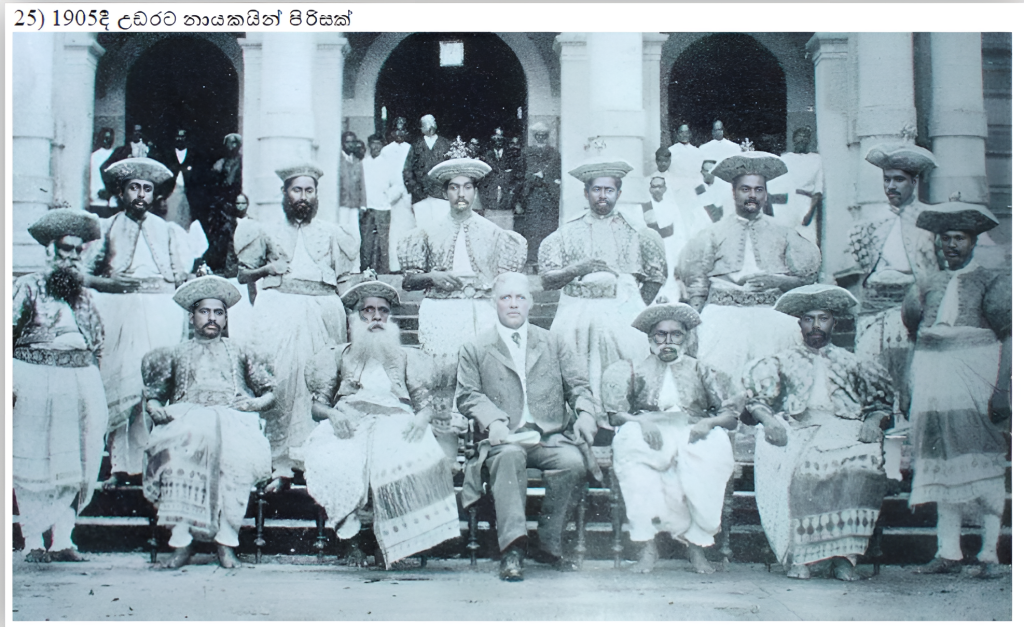
කොයි ලොව යන්නද ප්රභාකරන්
කොටි එනවා කියලා කවුද කෑ ගහනවා ඇහුණා. මමත් මිදුලට පැන්නා බලන්න. තුවක්කු අතින් අරගෙන කට්ටියක් ඉන්නවා. දෙමළෙනුයි ඒ අය කතා කෙළේ. එකපාරට උන් වෙඩි තියන්න ගත්තා. මම දිව්වා. දුවලා ගිහිල්ලා අඳුරන අයියා කෙනෙක්ගේ ගෙදරට ගියා. එයා තුවක්කුවත් අරගෙන ඇවිල්ලා වෙඩි තියද්දි කොටි පැනලා දිව්වා. පස්සේ බලනකොට අම්මයි, තාත්තයි, අක්කයි, අක්කගේ ළමයි දෙන්නයි මරලා දාලා තිබුණා. මල්ලි ගේ ඇතුළේ ඇඳක් යට රිංගලා ඉඳලා ජීවිතේ බේරගෙන තිබුණා.
මේ; අරුණ ශාන්ත. ඔහු නෙල්ලියද්ද විද්යාලයේ 8 ශ්රේණියේ ශිෂ්යයෙක්. 2009 වර්ෂයේ පෙබරවාරි මස 22 වැනිදා ත්රස්තවාදීන් ඉඟිනියාගල කරමැටියාව ගමට පහර දී ගම්වාසීන් 16 දෙනෙකු ඝාතනය කර තවත් පිරිසකට බරපතළ තුවාල සිදුකරමින් කළ කුරිරු අපරාධය ඔහු සියැසින් දැක ගත්තේ එලෙසිනි. මෙය එක් අවාසනාවන්ත සිදුවීමක් පමණි.
මෙරට ත්රස්තවාදී ව්යාපාර ආරම්භයේ කියා සිටියේ තමන් ජනතාවගේ අයිතිවාසිකම්, අවශ්යතා සඳහා සටන් කරන බව ය. නමුත් සිදුවූයේ විමුක්තිකාමින් ලෙස පෙනී සිටි ත්රස්තවාදීන් අතින් දහස් ගණනක් පුරවැසියන් කුරිරු ලෙස ඝාතනය වීම ය.
දෙමළ සන්නද්ධ ව්යාපාර මෙරට උපත ලැබූ වකවානුව වූයේ 1970 දශකයේ ආරම්භයයි. මේ සන්නද්ධ ව්යාපාරයන්හි පළමු උණ්ඩයට බිලිවූයේ කුලී රථ රියැදුරෙකි. උලගනාදන් නම් වූ ඔහු 1972 ජූනි මස 04 වෙනි දින තිරුනෙල්වෙලිහිදී සන්නද්ධ කණ්ඩායමක් අතින් ඝාතනය විය. එදා සිට අද දක්වා ත්රස්තවාදීන් අහිංසක සිවිල් ජනතාව මහමඟ නැතිනම් නිදි පැදුරේම කුරිරු ලෙස සමූහ ලෙස ඝාතනය කෙරිණි.

 ප්රභාකරන් නොහැඳීනූ දරු දුක ප්රභාකරන් නොහැඳීනූ දරු දුක |
මෙහිදී එල්.ටී.ටී.ඊ.ය සිදුකළ කුරිරු ඝාතන ඉතා විශාල ප්රමාණයක් පසුගිය දශක තුනකට වැඩි කාල පරිච්ඡේදය තුළ වාර්තා වේ.
1984 නොවැම්බර් මස 30 වෙනි දින වැලිඔය ඩොලර් ෆාම් සහ කෙනට් පාම් යනුවෙන් හැදින් වූ ගොවිපොළවලට කඩාවැදුණු ත්රස්තවාදීන් මුළු ගොවිපොළම වටකර වෙඩි තැබූහ. පිරිසක් මිය යද්දී සෙසු පිරිස එල්ලවන වෙඩි වරුසා මැද අසරණව ජීවිතය බේරා ගන්නට කැලයට දිවයාමට උත්සාහ කළහ.
එහෙත් තුවක්කු මානගත් ත්රස්තවාදීහු එම ජනතාව වටකර අත්පා ගැට ගැසූහ. ත්රස්තයන් කෙතරම් නින්දිත ලෙස හැසිරුනේද යත් අතපය බැඳි මිනිසුන්ගේ ශරීරවලට මුත්රා පවා කෙළේය. අවසානයේ සියලු දෙනාගේම හිසට, බෙල්ලට වෙඩි තබා ඝාතනය කළහ. මින් ගොවිපොළවාසීන් 62 ක් මියගියහ.
 1985 ජනවාරි 9 වෙනි දින යාල්දේවි දුම්රියට එල්.ටී.ටී.ඊ.ය විසින් මුරුක්කන්හිදී ප්රහාරයක් එල්ල කෙරිණි. හමුදා සාමාජිකයන් 29 ක් සහ සිවිල් වැසියන් 11 ක් මේ ප්රහාරයෙන් මිය ගියහ.
1985 ජනවාරි 9 වෙනි දින යාල්දේවි දුම්රියට එල්.ටී.ටී.ඊ.ය විසින් මුරුක්කන්හිදී ප්රහාරයක් එල්ල කෙරිණි. හමුදා සාමාජිකයන් 29 ක් සහ සිවිල් වැසියන් 11 ක් මේ ප්රහාරයෙන් මිය ගියහ.
1985 මැයි 14 වෙනි දින අනුරාධපුර පූජා භූමිය එල්.ටී.ටී.ඊ. ත්රස්තවාදීන් විසින් ලේ විලක් කරන ලදී. පළමුව ලංගම බස් රථයක් පැහැරගත් ත්රස්තවාදීන් අවි අමෝරාගෙන අනුරාධපුර පුදබිමට කඩා පැන්නේය. සුදු පැහැ වස්ත්රයෙන් සැරසී මහත් භක්තියෙන් ශ්රී මහා බෝධීන් වහන්සේ වන්දනා කරමින් සිටි 146 දෙනෙකු අමු අමුවේම ඝාතනය කර ත්රස්තවාදීහූ පලා ගියහ. මේ ප්රහාරයෙන් 285 දෙනෙකු බරපතළ තුවාල ලැබූහ.
1986 මැයි 03 දින එලිෆන්ට් හවුස් ආයතනයේදී බෝම්බයක් පුපුරවා හරිමින් සිවිල් වැසියන් 11 දෙනෙක් ඝාතනය කරන ලදී.
1987 අප්රියෙල් 17 වෙනිදා හබරණ සිට ති්රකුණාමලය දක්වා ගමන්ගත් බස් රථ දෙකක සිටි 127 දෙනෙකු කිතුල්උතුව ප්රදේශයේදී කපා කොටා කුරිරු ලෙස එල්.ටී.ටී.ඊ.ය විසින් ඝාතනය කරන ලදී. මේ ඝාතනය සිදුවනවිට අප්රියෙල් 12 වෙනිදා සිට සටන් විරාමයක් ප්රකාශ කෙරී තිබුණි.
1987 අප්රියෙල් 21 වෙනිදා පිටකොටුව බස් නැවතුමේ බෝම්බයක් පුපුරවා හැරිණි. 114 ක් මියගිය අතර තුන්සිය ගණනක් තුවාල ලැබීය.
 1992 අප්රියෙල් 29 අලංචිපොතාන ගම්මානයට පහර දී සිවිල් වැසියන් 50 කට වැඩි පිරිසක් ඝාතනය කරන ලදී.
1992 අප්රියෙල් 29 අලංචිපොතාන ගම්මානයට පහර දී සිවිල් වැසියන් 50 කට වැඩි පිරිසක් ඝාතනය කරන ලදී.
1992 – 715 මඩකළපුව කිරාන්කුලම් හිදී බසයකට පහර දී එහි සිටි මුස්ලිම් වැසියන් 19 ක් ඝාතනය කළහ.
1992 ඔක්තෝම්බර් 5 පල්ලියගොඩැල්ල, අහමද්පුර, අග්බෝපුර ගම් තුනට එල්.ටී.ටී.ඊ.ය පහර දී වැසියන් 146 ක් ඝාතනය කරන ලදී. 83 කට තුවාල සිදුවිය.
1995.10.21 සිට 26 දක්වා වූ කාලය තුළ අම්පාර, කැබිතිගොල්ලෑව, පදවිය, පොළොන්නරුව ප්රදේශයන්හි ගම්වාසින් 139 දෙනෙකු ඝාතනය කෙරිණි.
1996 ජනවාරි 31 වෙනි දින කොළඹ මහ බැංකු ගොඩනැගිල්ලට ත්රස්තවාදීන් පහර දෙන ලදී. එහිදී 91 ක් මියගිය අතර 1338 කට තුවාල සිදුවූහ.
1996.07.24 වෙනි දින කොළඹ කොටුව සිට අලුත්ගම දක්වා ධාවනය වූ දුම්රියේ බෝම්බයක් දෙහිවල දුම්රිය ස්ථානයේදී පුපුරා යාමෙන් මගීන් 64 ක් මිය ගියහ. 400 කට අධික පිරිසකට තුවාල සිදුවිය.
1998 ජනවාරි මස 25 ඓතිහාසික දළදා මාලිගාවට කොටි ත්රස්තවාදීන් පහර දුනි. මෙරට 50 වෙනි නිදහස් සංවත්සරයේ නිල උත්සවය පැවැත්වීමට නියමිතව තිබුණේ මහනුවර දළදා මාලිගා භූමියේදී ය. ප්රහාරයෙන් පසුව රජය නිල උත්සවය කොළඹ පැවැත්වීමට කටයුතු කෙළේය. ප්රහාරයෙන් 14 දෙනෙක් මිය ගියේය.
2006 ජූනි 15 වෙනි දින කැබිතිගොල්ලෑව බසයක් ඉලක්ක කර ගෙන එල්.ටී.ටී.ඊ. ත්රස්තවාදීන් විසින් පුපුරුවා හරින ලද ක්ලේමෝ බෝම්බ ප්රහාරයකින් බසයේ ගමන් ගත් 64 ක් මිය ගියේය.
2007 නොවැම්බර් 28 දින නුගේගොඩ පෞද්ගලික ව්යාපාරික ආයතනයක් ඉදිරිපිට පුපුරා ගිය කාල බෝම්බයකින් සිවිල් වැසියන් 19 ක් මියගොස් 38 ක් තුවාල ලැබීය.
මෙලෙස එල්.ටී.ටී.ඊ. ත්රස්තවාදීන් විසින් අවස්ථා ගණනාවකදී අහිංසක සිවිල් ජනතාව අමානුෂික ලෙස ඝාතනය කරන ලදී. තමා සිංහලද, දෙමළ ද, මුස්ලිම් ද නැත්නම් යුද්ධය කුමක්ද ත්රස්තවාදය කුමක්ද ඒ කිසිවක් නොදන්නා අහිංසක ළදරුවෝද ත්රස්තවාදයේ ම්ලේච්ඡත්වයට පසුගිය දශක කිහිපය තුළ මුහුණ දුන්හ.
මානුෂික මෙහෙයුම් අවසාන අදියර කරා පැමිණෙද්දී ආරක්ෂක හමුදාවන්හි ඉදිරි ගමන වැළැක්වීමට ත්රස්තවාදීන් සිවිල් ජනතාව පලිහක් ලෙස යොදා ගත්හ. ජනතාවට විමුක්තිය ලබාදෙනවා යැයි කියමින් සිය ත්රස්තවාදී ව්යාපාරය ආරම්භ කළ කොටින් තම ආරක්ෂාව සපයා ගැනීමට අහිංසක සිවිල් ජනතාව ඉදිරියට දැම්මේය. එපමණක් නොව ජනතාව සැබෑ තතු තේරුම් ගෙන ආරක්ෂක හමුදා සමඟ එක්වද්දී ත්රස්තයන් අමානුෂික ලෙස අවස්ථා ගණනකදී ජනතාවට වෙඩි තැබූහ. ඒ කොටි ත්රස්තවාදීන් ජනතාවට විමුක්තිය ලබාදීමට කටයුතු කළ ආකාරයයි.
ඒ සියලු අභියෝග මැදින් අද ජනතාවට නිදහස කුමක්දැයි තේරුම් ගත හැකි යුගය උදාවෙමින් පවතී.
රජීව් ඝාතනයට කොටි සැලැසුම් කළ හැටි

රජීව් ඝාතනයට කොටි සැලැසුම් කළ හැටිජීව් ගාන්ධි ඝාතනයට අවශ්ය සියලු කටයුතු සූදානම් ය.එහෙත්; ඝාතකයන්ට ප්රභූ ආරක්ෂාව පිළිබඳව ගැටලුවක් තිබුණි. ආරක්ෂක භටයන් ගෙන් මිදී රජීව් ගාන්ධි සමීපයට යාහැකි දැයි යන්න ඒ වනතෙක් නොවිසඳී තිබුණි. සැකය දුරු කර ගැනීම සඳහා ත්රස්තවාදීන් පෙරහුරුවක් සූදානම් කෙළේ ය. මේ සඳහා තෝරා ගත්තේ එවක ඉන්දීය අගමැති වී. පී. සිං මහතා ගේ මැතිවරණ රැලියකි.  මැතිවරණ රැලිය පැවැත්වීමට තිබූ දින සිවරාසන්, ධනු සහ සුබා මෙන්ම ඡායාරූප ශිල්පියකු ද මදුරාසියේ සිට සැතැපුම් 25 ක් පමණ දුරින් පැවැති අගමැතිවරයාගේ ප්රචාරක රැලියට සහභාගී විය. රැස්වීම අවසානයේ අගමැතිවරයා පිටත්වන්නට සූදානම් විය. “ධනු” ඉදිරියට විත් හින්දු චාරිත්ර අනුව වැඩිහිටියන්ට ගරු කිරීම වස් අගමැතිවරයාගේ පාද ස්පර්ශ කළාය. මේ සියල්ල කැමරා ශිල්පියා සිය කැමරාවේ පියවරක් පියවරක් පාසා සටහන් කර ගත්තේය. පෙරහුරුව සාර්ථක ය. ප්රභූ ආරක්ෂාව සම්බන්ධයෙන් ගැටලුවක් නොමැත.එවක ඉන්දියාවේ රාජ්ය නායකයා සමීපයට යාමට ම ඔවුන්ට හැකි විය. එහෙත් යම් හෝ අඩු පාඩුවක් වුණි ද? යන සැකයක් පැන නැගිණි. ඒ අනුව වාසස්ථානය වෙත ගිය ත්රස්තවාදීන් ලබාගත් ඡායාරූප මඟින් අඩුපාඩු නිරීක්ෂණය කරන්නට වුණි. සැලැස්ම නිවැරැදිය. දැන් ත්රස්තවාදීන් ගේ අවසාන සැකය ද දුරුවී ගොස් ය. ඉතා පහසුවෙන් තම ඉලක්කය කරා ළඟා වීමට අවශ්ය ආකාරය ඔවුහු දැනගත්හ.මේ අතර 1991 මැයි මාසයේ රජීව් ගාන්ධි මහතාගේ මැතිවරණ ප්රචාරක රැලි පිළිබඳ විස්තරයක් පුවත්පත් හි පළ විය. ඉන් වඩාත් පහසු රැලිය ඔවුන් සිය ඉලක්කය සපුරා ගැනීමට සොයා ගත්තේය. ඒ; 1991 මැයි 21 වෙනි දින මදුරාසියේ ශී්ර පෙරුම්බුදූර් නම් නගරයේ පැවැත්වීමට නියමිත ජනතා රැලියයි.ඝාතනයට නියමිත දිනට පෙර දිනයක නාලනී, ධනු, සුබා යන තිදෙනා “විල්ලි මාක්කම්” නම් ස්ථානයේ පිහිටි දේවාලයකට ගොස් සිය අභිමතාර්ථ ඉෂ්ට වේවා යැයි ප්රාර්ථනා ද කළ බව කියැවේ. මැතිවරණ රැලිය පැවැත්වීමට තිබූ දින සිවරාසන්, ධනු සහ සුබා මෙන්ම ඡායාරූප ශිල්පියකු ද මදුරාසියේ සිට සැතැපුම් 25 ක් පමණ දුරින් පැවැති අගමැතිවරයාගේ ප්රචාරක රැලියට සහභාගී විය. රැස්වීම අවසානයේ අගමැතිවරයා පිටත්වන්නට සූදානම් විය. “ධනු” ඉදිරියට විත් හින්දු චාරිත්ර අනුව වැඩිහිටියන්ට ගරු කිරීම වස් අගමැතිවරයාගේ පාද ස්පර්ශ කළාය. මේ සියල්ල කැමරා ශිල්පියා සිය කැමරාවේ පියවරක් පියවරක් පාසා සටහන් කර ගත්තේය. පෙරහුරුව සාර්ථක ය. ප්රභූ ආරක්ෂාව සම්බන්ධයෙන් ගැටලුවක් නොමැත.එවක ඉන්දියාවේ රාජ්ය නායකයා සමීපයට යාමට ම ඔවුන්ට හැකි විය. එහෙත් යම් හෝ අඩු පාඩුවක් වුණි ද? යන සැකයක් පැන නැගිණි. ඒ අනුව වාසස්ථානය වෙත ගිය ත්රස්තවාදීන් ලබාගත් ඡායාරූප මඟින් අඩුපාඩු නිරීක්ෂණය කරන්නට වුණි. සැලැස්ම නිවැරැදිය. දැන් ත්රස්තවාදීන් ගේ අවසාන සැකය ද දුරුවී ගොස් ය. ඉතා පහසුවෙන් තම ඉලක්කය කරා ළඟා වීමට අවශ්ය ආකාරය ඔවුහු දැනගත්හ.මේ අතර 1991 මැයි මාසයේ රජීව් ගාන්ධි මහතාගේ මැතිවරණ ප්රචාරක රැලි පිළිබඳ විස්තරයක් පුවත්පත් හි පළ විය. ඉන් වඩාත් පහසු රැලිය ඔවුන් සිය ඉලක්කය සපුරා ගැනීමට සොයා ගත්තේය. ඒ; 1991 මැයි 21 වෙනි දින මදුරාසියේ ශී්ර පෙරුම්බුදූර් නම් නගරයේ පැවැත්වීමට නියමිත ජනතා රැලියයි.ඝාතනයට නියමිත දිනට පෙර දිනයක නාලනී, ධනු, සුබා යන තිදෙනා “විල්ලි මාක්කම්” නම් ස්ථානයේ පිහිටි දේවාලයකට ගොස් සිය අභිමතාර්ථ ඉෂ්ට වේවා යැයි ප්රාර්ථනා ද කළ බව කියැවේ. ගාන්ධි පැමිණෙන තෙක් බලා සිටින ධනුඑහෙත් මැයි මස විසිවන දින වනවිට ත්රස්තවාදීන් ට නොසිතූ අකර තැබ්බයකට මුහුණ පාන්නට සිදුවිය. බෝම්බය පැලඳ යාමට සිටි ධනු එදින බලවත් ලෙස රෝගාතුර වූවා ය. පසුදින කාර්යය කිරීමට ඉතා අපහසු තත්ත්වයට ඇය පත්ව සිටියා ය. මේ අනුව වසර ගණනාවක සැලැස්ම අවසානයේ විනාශ වී යන තත්ත්වයක් උදාවී තිබුණි. එහිදී වහා කි්රයාත්මක වූ ත්රස්තවාදීන් සමඟ සිටි හෙදියක් ධනුව තමා සේවය කළ හෙදි නිවාසය කරා ගෙන ගියා ය. එහිදී ඇයට පෙති වර්ග කිහිපයක් ලබා දුන්නා ය.21 වෙනිදා වනවිට ධනු ප්රකෘතිමත් වී සිටියා ය. එදින සන්ධ්යා බාගය උදාවත්ම සුබා විසින් ඇයට ඝාතක කබාය ඇන්ද වූවාය. කිලෝ බාගයක් පමණ වූ සී ෆෝර්, ආර්. ඩී. එක්ස් නම් වූ අධි බලැති පුුපුරණ ද්රව්ය හා කුඩා ඊයම් බෝල දහස් ගණනක් පමණ එහි අන්තර්ගත වී තිබුණි. ඝාතක කබායට උඩින් රඹ පැහැගත් දීප්තිමත් සල්වාර් කමීශ් ඇඳුමකින් ඇය සැරසුණා ය.සිවරාසන්, ධනු, සුබා, නාලනී සහ ඡායාරූප ශිල්පී හරිබාබු ශී්ර පෙරුම් බුදුර් ප්රදේශය කරා ළඟා වූයේ ඊළඟට ය. ඇය රජීව් ගාන්ධි පිළිගැනීමට මල් කළඹක් ද අතට ගත්තා ය. නාලනී සහ සුබා ජනතාව සඳහා වෙන්කර තිබූ ප්රදේශයේ අසුන් ගත්තා ය. ප්රභූ ආරක්ෂිත ප්රදේශයේ ධනු රැදී සිටින විට ඇයගෙන් පොලිස් කාන්තාවක් ප්රශ්න කිරීමට පෙළඹුණා ය. වහාම කි්රයාත්මක වූ හරිබාබු ඇය මල්මාලාවක් පලඳවන බවත් තමා ඒ අවස්ථාව ඡායාරූප ගත කිරීමට සිටින බවත් ප්රකාශ කෙළේ ය.රාතී්ර 10.00 ලෙස වේලාව සටහන් වෙමින් තිබුණි. ජනතාව එක්වරම පී්රති ඝෝෂා නඟන්නට විය. ඒ ඉන්දියාවේ අනාගත අගමැතිවරයා වීමට නියමිතව සිටි රජීව් ගාන්ධිගේ පැමිණීමත් සමඟ ය. ගුණ වර්ණනා කවියක් ඉදිරිපත් කිරීම සඳහා කාන්තාවක් සිය දියණිය ගාන්ධි සමීපයට යැවුවා ය. ධනු ද ඇය පිටුපසින් ගොස් ගාන්ධි වෙත සමීප වූවාය.හරිබාබු ගේ කැමරාව සෑම දෙයක්ම සටහන් කර ගනිමින් සිටියි. දැන් ධනුුගේ වාරයයි. පළමුව ඇය මල්මාලාව ගෙන ගාන්ධි ගේ ගෙල වටා දැමුවා ය. ඒ සමඟම ඇය හින්දු චාරිත්ර අනුව සිය නායකයාට ගරු කිරීම වස් පාද ස්පර්ශයට ඉදිරියට නැමුණාය. ගාන්ධි ද ඇය එසවීමට ඉදිරියට නැමුණි. ධනු නොනැගිටම තම ඉණෙහි පැලැදි ස්විචය කි්රයාත්මක කළාය. කන් බිහිරි කරවමින් නගරයම එකම හඬක් නංවා මොහොතකට නිහඬ විය. රැස්ව සිටි පිරිස ගාන්ධි පැලඳ සිටි පාවහන් යුගලින් ඔහුගේ සිරුර හඳුනා ගන්නට සමත් විය.ඉන්දියාවේ හිටපු අගමැති රජීව් ගාන්ධි ඝාතනය ලෝකයාම මහත් කම්පාවට පත් කෙළේ ය. ඝාතනය එල්. ටී. ටී. ඊ ය මෙන්ම තවත් පාර්ශ්ව වෙත ද යොමුවන්නට විය. එහෙත් එල්. ටී. ටී. ඊ ය එය ප්රතික්ෂේප කෙළේ ය. මෙහි පර්යේෂණ බාරව සිටි ඉන්දීය විශේෂ විමර්ශන ඒකකයේ ප්රධානියා වූ ඩී. ආර්. කාර්තිකේසන් මහතා එල්. ටී. ටී. ඊ ය ඝාතනයට සම්බන්ධ බව මෙන්ම ඔවුන් ගේ සැලැසුම් සියලුම අංගද නිසි අයුරින් තහවුරු කෙළේ ය. පර්යේෂණ සඳහා හරිබාබුගේ කැමරාව සාක්ෂි ගණනාවක් සපයා තිබුණි. හරිබාබු සහ මොන්මුලි රාජරත්නම් හෙවත් ධනු ප්රහාරයෙන් මිය ගියද හරිබාබුගේ කැමරා පටලයේ ඝාතනයට සම්බන්ධ සිවරාසන් (එකැස් කොල්ලා) ධනු, නාලනී, සුබා ගේ ඡායාරූප නිරුපද්රිතව තිබිණි. පර්යේෂණ අවසානයේ එල්. ටී. ටී. ඊ යට ඝාතන වගකීම පිළිගන්නට විය. ගාන්ධි පැමිණෙන තෙක් බලා සිටින ධනුඑහෙත් මැයි මස විසිවන දින වනවිට ත්රස්තවාදීන් ට නොසිතූ අකර තැබ්බයකට මුහුණ පාන්නට සිදුවිය. බෝම්බය පැලඳ යාමට සිටි ධනු එදින බලවත් ලෙස රෝගාතුර වූවා ය. පසුදින කාර්යය කිරීමට ඉතා අපහසු තත්ත්වයට ඇය පත්ව සිටියා ය. මේ අනුව වසර ගණනාවක සැලැස්ම අවසානයේ විනාශ වී යන තත්ත්වයක් උදාවී තිබුණි. එහිදී වහා කි්රයාත්මක වූ ත්රස්තවාදීන් සමඟ සිටි හෙදියක් ධනුව තමා සේවය කළ හෙදි නිවාසය කරා ගෙන ගියා ය. එහිදී ඇයට පෙති වර්ග කිහිපයක් ලබා දුන්නා ය.21 වෙනිදා වනවිට ධනු ප්රකෘතිමත් වී සිටියා ය. එදින සන්ධ්යා බාගය උදාවත්ම සුබා විසින් ඇයට ඝාතක කබාය ඇන්ද වූවාය. කිලෝ බාගයක් පමණ වූ සී ෆෝර්, ආර්. ඩී. එක්ස් නම් වූ අධි බලැති පුුපුරණ ද්රව්ය හා කුඩා ඊයම් බෝල දහස් ගණනක් පමණ එහි අන්තර්ගත වී තිබුණි. ඝාතක කබායට උඩින් රඹ පැහැගත් දීප්තිමත් සල්වාර් කමීශ් ඇඳුමකින් ඇය සැරසුණා ය.සිවරාසන්, ධනු, සුබා, නාලනී සහ ඡායාරූප ශිල්පී හරිබාබු ශී්ර පෙරුම් බුදුර් ප්රදේශය කරා ළඟා වූයේ ඊළඟට ය. ඇය රජීව් ගාන්ධි පිළිගැනීමට මල් කළඹක් ද අතට ගත්තා ය. නාලනී සහ සුබා ජනතාව සඳහා වෙන්කර තිබූ ප්රදේශයේ අසුන් ගත්තා ය. ප්රභූ ආරක්ෂිත ප්රදේශයේ ධනු රැදී සිටින විට ඇයගෙන් පොලිස් කාන්තාවක් ප්රශ්න කිරීමට පෙළඹුණා ය. වහාම කි්රයාත්මක වූ හරිබාබු ඇය මල්මාලාවක් පලඳවන බවත් තමා ඒ අවස්ථාව ඡායාරූප ගත කිරීමට සිටින බවත් ප්රකාශ කෙළේ ය.රාතී්ර 10.00 ලෙස වේලාව සටහන් වෙමින් තිබුණි. ජනතාව එක්වරම පී්රති ඝෝෂා නඟන්නට විය. ඒ ඉන්දියාවේ අනාගත අගමැතිවරයා වීමට නියමිතව සිටි රජීව් ගාන්ධිගේ පැමිණීමත් සමඟ ය. ගුණ වර්ණනා කවියක් ඉදිරිපත් කිරීම සඳහා කාන්තාවක් සිය දියණිය ගාන්ධි සමීපයට යැවුවා ය. ධනු ද ඇය පිටුපසින් ගොස් ගාන්ධි වෙත සමීප වූවාය.හරිබාබු ගේ කැමරාව සෑම දෙයක්ම සටහන් කර ගනිමින් සිටියි. දැන් ධනුුගේ වාරයයි. පළමුව ඇය මල්මාලාව ගෙන ගාන්ධි ගේ ගෙල වටා දැමුවා ය. ඒ සමඟම ඇය හින්දු චාරිත්ර අනුව සිය නායකයාට ගරු කිරීම වස් පාද ස්පර්ශයට ඉදිරියට නැමුණාය. ගාන්ධි ද ඇය එසවීමට ඉදිරියට නැමුණි. ධනු නොනැගිටම තම ඉණෙහි පැලැදි ස්විචය කි්රයාත්මක කළාය. කන් බිහිරි කරවමින් නගරයම එකම හඬක් නංවා මොහොතකට නිහඬ විය. රැස්ව සිටි පිරිස ගාන්ධි පැලඳ සිටි පාවහන් යුගලින් ඔහුගේ සිරුර හඳුනා ගන්නට සමත් විය.ඉන්දියාවේ හිටපු අගමැති රජීව් ගාන්ධි ඝාතනය ලෝකයාම මහත් කම්පාවට පත් කෙළේ ය. ඝාතනය එල්. ටී. ටී. ඊ ය මෙන්ම තවත් පාර්ශ්ව වෙත ද යොමුවන්නට විය. එහෙත් එල්. ටී. ටී. ඊ ය එය ප්රතික්ෂේප කෙළේ ය. මෙහි පර්යේෂණ බාරව සිටි ඉන්දීය විශේෂ විමර්ශන ඒකකයේ ප්රධානියා වූ ඩී. ආර්. කාර්තිකේසන් මහතා එල්. ටී. ටී. ඊ ය ඝාතනයට සම්බන්ධ බව මෙන්ම ඔවුන් ගේ සැලැසුම් සියලුම අංගද නිසි අයුරින් තහවුරු කෙළේ ය. පර්යේෂණ සඳහා හරිබාබුගේ කැමරාව සාක්ෂි ගණනාවක් සපයා තිබුණි. හරිබාබු සහ මොන්මුලි රාජරත්නම් හෙවත් ධනු ප්රහාරයෙන් මිය ගියද හරිබාබුගේ කැමරා පටලයේ ඝාතනයට සම්බන්ධ සිවරාසන් (එකැස් කොල්ලා) ධනු, නාලනී, සුබා ගේ ඡායාරූප නිරුපද්රිතව තිබිණි. පර්යේෂණ අවසානයේ එල්. ටී. ටී. ඊ යට ඝාතන වගකීම පිළිගන්නට විය. ගාන්ධි ඝාතනයට මොහොතකට පෙරරජිව් ගාන්ධි ඝාතන කුමන්ත්රණය එල්. ටී. ටී. ඊ ය 1987 වර්ෂයේ සිටම සැලැසුම් කර තිබූ බව පෙනී ගොස් ඇත. ප්රභාකරන්, පොට්ටු අම්මාන්, කොටි සංවිධානයේ කාන්තා අංශයේ උප නායිකා අකිලා අතර මේ ඝාතනයේ සැලැසුම් කි්රයාත්මක වී ඇත.ඉන්දු – ලංකා ගිවිසුම අස්සන් කිරීම, ඉන්දු ලංකා ගිවිසුමට එරෙහිව උපවාස කළ තිලීපන් උපවාසයෙන් මිය යද්දී ඒ පිළිබඳ අවධානය යොමු නොකිරීම සහ එල්. ටී. ටී. ඊ බෝට්ටුවක් අත්අඩංගුවට ගෙන එහි සිටි කොටි සාමාජිකයන් 17 ක් ශී්ර ලංකා හමුදාවට බාරදීමට කටයුතු කිරීම රජීව් ගාන්ධි ඝාතනය ප්රධාන වශයෙන්ම බලපා තිබෙන බව විශ්වාස කෙරේ. (17 දෙනාගෙන් 12 දෙනෙක් ප්රභාකරන් නියෝගය මත සයනයිඩ් කා මිය ගියහ.) රජීව් ගාන්ධි මහතා අගමැතිවරයා වශයෙන් සිටින විට මෙම අවස්ථා තුනටම කොටි ත්රස්තවාදීහු මුහුණ දුන්හ. ඒ සමඟම 1991 දී පැවැත්වීමට නියමිතව තිබූ මැතිවරණයෙන් රජීව් ගාන්ධි මහතා නැවත වරක් ඉන්දියාවේ අගමැති වන ලකුණු පෙනෙන්නට තිබුණි. එසේම ඉන්දු – ලංකා ගිවිසුම අවලංගු වී නැතැයි යනුවෙන් පුවත්වතකට ප්රකාශ කර තිබුණි. මෙනිසා එල්. ටී. ටී. ඊ යට ඉන්දියානු නායකයා ගේ කි්රයා කලාපය ගැන සැක මතුවිය. ඔහු අගමැතිවීම තමාට තර්ජනයක් බව ප්රභාකරන් කල්පනා කෙළේ ය. ඒ අනුව ඝාතන සැලැස්ම කි්රයාත්මක කර තිබුණි.ඝාතන සැලැස්ම කි්රයාත්මක වන අතරතුර ප්රභාකරන් ඉන්දියාව සමඟ සුහදව සිටින බව ඇගැයීමට උත්සාහ කෙළේ ය. විශේෂයෙන් ම කාසි ආනන්දන් මඟින් ප්රභාකරන් රජීව් ගාන්ධි ට සුබ පැතුම් ද යවා තිබුණි. මේ අනුව ප්රභාකරන් පරණ ප්රශ්න සියල්ල අමතක කර අනාගත ඉන්දීය අගමැතිවරයා ට සමීප වීමට උත්සාහ කරන බවක් පෙන්වීය. එහෙත් ඒ වන විටත් පොට්ටු අම්මාන්ට රජීව් ඝාතනයට අවශ්ය සියලු කටයුතු කි්රයාත්මක කිරීමට උපදෙස් ලබා දී තිබුණි.මේ අනුව ප්රභාකරන් සහ පොට්ටු අම්මාන් විසින් සිවරාසන්, නික්සන් කන්දන්, මුතුරාජා, මුරුගන්, නාලනී, සුබා, කණ්ඩායම් තුනක් ලෙස යොදා ගනිමින් අවශ්ය මිනිස් බෝම්බය සැකැසුවේ ය. සැලැස්ම අවසානයේ ඔහු විසින් රජීව් ගාන්ධි නම් ඉන්දීය ජනතාවගේ අසහාය නායකයා විනාශ කරන ලද්දේ සමස්ත භාරතයම මහත් කම්පාවට පත් කරමිනි. ගාන්ධි ඝාතනයට මොහොතකට පෙරරජිව් ගාන්ධි ඝාතන කුමන්ත්රණය එල්. ටී. ටී. ඊ ය 1987 වර්ෂයේ සිටම සැලැසුම් කර තිබූ බව පෙනී ගොස් ඇත. ප්රභාකරන්, පොට්ටු අම්මාන්, කොටි සංවිධානයේ කාන්තා අංශයේ උප නායිකා අකිලා අතර මේ ඝාතනයේ සැලැසුම් කි්රයාත්මක වී ඇත.ඉන්දු – ලංකා ගිවිසුම අස්සන් කිරීම, ඉන්දු ලංකා ගිවිසුමට එරෙහිව උපවාස කළ තිලීපන් උපවාසයෙන් මිය යද්දී ඒ පිළිබඳ අවධානය යොමු නොකිරීම සහ එල්. ටී. ටී. ඊ බෝට්ටුවක් අත්අඩංගුවට ගෙන එහි සිටි කොටි සාමාජිකයන් 17 ක් ශී්ර ලංකා හමුදාවට බාරදීමට කටයුතු කිරීම රජීව් ගාන්ධි ඝාතනය ප්රධාන වශයෙන්ම බලපා තිබෙන බව විශ්වාස කෙරේ. (17 දෙනාගෙන් 12 දෙනෙක් ප්රභාකරන් නියෝගය මත සයනයිඩ් කා මිය ගියහ.) රජීව් ගාන්ධි මහතා අගමැතිවරයා වශයෙන් සිටින විට මෙම අවස්ථා තුනටම කොටි ත්රස්තවාදීහු මුහුණ දුන්හ. ඒ සමඟම 1991 දී පැවැත්වීමට නියමිතව තිබූ මැතිවරණයෙන් රජීව් ගාන්ධි මහතා නැවත වරක් ඉන්දියාවේ අගමැති වන ලකුණු පෙනෙන්නට තිබුණි. එසේම ඉන්දු – ලංකා ගිවිසුම අවලංගු වී නැතැයි යනුවෙන් පුවත්වතකට ප්රකාශ කර තිබුණි. මෙනිසා එල්. ටී. ටී. ඊ යට ඉන්දියානු නායකයා ගේ කි්රයා කලාපය ගැන සැක මතුවිය. ඔහු අගමැතිවීම තමාට තර්ජනයක් බව ප්රභාකරන් කල්පනා කෙළේ ය. ඒ අනුව ඝාතන සැලැස්ම කි්රයාත්මක කර තිබුණි.ඝාතන සැලැස්ම කි්රයාත්මක වන අතරතුර ප්රභාකරන් ඉන්දියාව සමඟ සුහදව සිටින බව ඇගැයීමට උත්සාහ කෙළේ ය. විශේෂයෙන් ම කාසි ආනන්දන් මඟින් ප්රභාකරන් රජීව් ගාන්ධි ට සුබ පැතුම් ද යවා තිබුණි. මේ අනුව ප්රභාකරන් පරණ ප්රශ්න සියල්ල අමතක කර අනාගත ඉන්දීය අගමැතිවරයා ට සමීප වීමට උත්සාහ කරන බවක් පෙන්වීය. එහෙත් ඒ වන විටත් පොට්ටු අම්මාන්ට රජීව් ඝාතනයට අවශ්ය සියලු කටයුතු කි්රයාත්මක කිරීමට උපදෙස් ලබා දී තිබුණි.මේ අනුව ප්රභාකරන් සහ පොට්ටු අම්මාන් විසින් සිවරාසන්, නික්සන් කන්දන්, මුතුරාජා, මුරුගන්, නාලනී, සුබා, කණ්ඩායම් තුනක් ලෙස යොදා ගනිමින් අවශ්ය මිනිස් බෝම්බය සැකැසුවේ ය. සැලැස්ම අවසානයේ ඔහු විසින් රජීව් ගාන්ධි නම් ඉන්දීය ජනතාවගේ අසහාය නායකයා විනාශ කරන ලද්දේ සමස්ත භාරතයම මහත් කම්පාවට පත් කරමිනි. |


ජීවිත 113ක් දැයට අහිමි කරමින් පිටකොටුව අධිබලැති බෝම්බය
ජීවිත 113ක් දැයට අහිමි කරමින් පිටකොටුව අධිබලැති බෝම්බය පිපිරී දැනට වසර 32 කි. ඒ බිහිසුණු පිපිරීම සිදුවූයේ 1987 අප්රේල් 21 වැනිදාය.

එසේම මිනිස් ජීවිත 300කට වැඩි ගණනක් අහිමිකරමින් පසුගිය පාස්කු ඉරිදා බෝම්බ වැලක් පුපුරා ගියේ පිටකොටුවේ බෝම්බය පිපිරූ දිනයේමය. ඒ 2019 අප්රේල් 21 දාය.
රටේ අගනගරය වූ කොළඹ පිටකොටුව රටේ ප්රබල ආර්ථික මධ්යස්ථානයකි. කඩිගුලක් මෙන් ජනගහනය බහුල ස්ථානයකි. එදිනෙදා රාජකාරි නිමවී තම නිවෙස්වලට යන ජනතාව ඇතුළුව දහස් සංඛ්යාත පිරිසක් පිටකොටුවට රැස්වීම සාමාන්ය දෙයකි.
1987 අප්රේල් 21 වැනිදාත් වෙනදා මෙන්ම පිටකොටුවේ සාමාන්ය ජනතාව රැස්ව සිටියහ.
අනතුරක් පිළිබඳ සේයාවක්වත් අහළක නොවීය. වේලාව සවස 4.30 පසුවූවා පමණි. කන් බිහිරි කරවන හඬක් නැගෙමින් සියල්ල උඩු යටිකුරු කර මුළු කොළඹම දෙදුරුම් කන්නට විය. ක්ෂණිකව සියල්ල නිහඬ විය. ඒ අවට සිටි පිරිසට සිදුවූයේ කුමක්ද? සිදුවන්නේ කුමක්දැයි සිතාගත නොහැකි විය.
ඒ මහා ශබ්දය නැගුණේ කොළඹ පිටකොටුව බස් නැවතුම්පළ පර්යන්තයේ පුපුරුවා හරින ලද බෝම්බ ප්රහාරයකිනි. පණ බේරා ගැනීමට හිස්ලුලූ අත දුවයන පිරිස පන්දහසකට අධිකය.
පිටකොටුව බෝගහ හන්දිය අසළ සුප්රකට පලතුරු බීම සාප්පුවක් වූයේ සිය රට පලතුරු බීම වෙළඳසලය. අප්රේල් 21 වැනිදා සවස 4 ට පමණ සියරට බීම සාප්පුව ළඟ රාජකාරියේ යෙදී සිටි පිටකොටුවේ පොලිස් රාළහාමිලා දෙදෙනෙක් තම සේවා මුරය නිමවා නැවත තම බැරැක්ක වෙත යාමට සූදානම් වූයේ පිටකොටුව පොලිසියේ මිට්සුබිෂි වර්ගයේ ජීප් රථයෙන්ය.
ජීප් රථයෙන් ගිනිඅවි අතැතිව එම ස්ථානයේ රාජකාරියට අනුයුක්ත කොට සිටි පොලිස් නිලධාරීන් සිව්දෙනා තම සේවා මුරයට සූදානම් වූයේ කිසිදු සුවිශේෂත්වයක් නැතුවය.
සියරට අලෙවිහලට මඳක් ඈතින් වූයේ සුදු පැහැති එස්කොට් වර්ගයේ රථයකි. එහි බොනට්ටුව විවෘත කරගෙන තරුණයන් දෙදෙනෙක් යම් අලුත්වැඩියා කටයුත්තක නියැළෙමින් සිටියහ.
ටී ෂර්ට් හැඳි තවත් තරුණයන් දෙදෙනෙකු එහි පසුපස ආසනයේ සිට නොසන්සුන් ලෙස වටපිට බලමින් යම් කටයුත්තක නියැළෙනු දුටු පොලිස් නිලධාරීහු ෆෝඩ් රථය අසළට ගොස් වාහන තදබදයක් ඇතිවන බැවින් වාහනය ඉදිරියට ගන්නා ලෙස නියෝග කළහ.
ෆෝඩ් කාරයේ සිටි තරුණයන් හතරදෙනා වහා රථය සියරට බීම සාප්පුව වෙත තල්ලු කරගෙන එන්නට වූහ. තල්ලු කරගෙන එන රථය ගැන කිසිවෙකු විශේෂත්වයක් දුටුවේ නැත. එහෙත් මේ සිව්දෙනෙකු විසින් තල්ලු කරගෙන එන්නේ එතැනින් ඔබමොබ යන සියයකට අධික පිරිසකගේ මරණ වරෙන්තුව බව කිසිවකුවත් මොහොතකටවත් සිතන්නට නැතුවාවන්නට ඇත.
සියරට බීම සාප්පුව අසළට වාහනය තල්ලු කරගෙන ආ සැණින් වාහනය කලින් නවතා තැබූ තැන යමක් අමතක වී ආවාක් මෙන් තරුණ පිරිස නැවත ඒ කරා ගමන් කරන්නට වූයේ කිසිදු විශේෂත්වයක් නැතුවය.
වාහනයේ රියැදුරු අසුනේ සිටි තරුණයා සිටියේ කිටි කිටියේ ස්ටියරින් වීල් එක අල්ලාගෙනය.
ෆෝඩ් රථය අසල පළාතම දුමෙන් වසා දමමින් තරුණයා රථය පණගන්වන්ට වූයේ කාස රෝගියෙකු මෙනි. රියැදුරු අසුණේ වූ තරුණයා තමන්ට යම් විධානයක් ලැබුණාක් මෙන් එතෙක් දෙපසකට කර තිබූ වයර් දෙකක් එක්කොට ඇඹරුවේ ආවේස වූවෙකු ලෙසය. ගතවූයේ තත්ත්පර ගණනකි. රියැදුරු අසුනේ සිටි තරුණයා වාහනය වටකොටගෙන සිටි පිරිස අතරින් කාටත් හොරා සැඟව ගියේය.
එවකට පිටකොටුව පොලිස් ස්ථානයේ ස්ථානාධිපතිවරයා වූයේ සුනිල් මලිගස්පේ මහතාය. හමුදා ඔත්තු සේවාවේ උපදෙස් මත පිටකොටුවේ ආරක්ෂාවට ඔහු යොදා සිටි පොලිස් බළඇණි ගණන 4 කි. සියරට බීම සාප්පුව ළඟ නතර කර ඇති ෆෝඩ් රථය ගැන ස්ථානාධිපති මලිගස්පේට දැනගන්නට ලැබෙන්නේ පැරණි නගරශාලාව අසළ සිට තම පොලිස් කණ්ඩායම්වලට උපදෙස් දෙමින් සිටියදීය.
තම ජීප් රිය බෝගහ හන්දිය දෙසට අඟලකුදු යා නොහැකි ලෙස පාර පුරා ජනකායක් වූ බැවින් පොලිස් පරීක්ෂකවරයා තම ජීප් රථයෙන් බැස්සේ පොලිස් පරීක්ෂක ශ්රීලාල් උපේන්ද්ර සහ උප පොලිස් පරීක්ෂක නෙවිල් ඇන්ටනි සමගය.
ගතවූයේ තත්පර ගණනකි. සියරට බීම සාප්පුවේ බිත්ති ඔරලෝසුව පස්වරු 4.30 ට කම්පනයෙන් නවතිද්දී මුළු පළාතම දෙවනත් කරමින් ෆෝර්ඩ් කාරයේ වූ බෝම්බය පුපුරා ගියේ සිය ගණනකගේ ජීවිත අහිමි කරමිනි. එය කොළඹ පිපුරූ එවැනි වර්ගයේ පළමු බෝම්බය විය. පසුව හෙළිවූයේ බෝම්බයේ බර කිලෝ හැටක් පමණ වූ බවය.
පිටකොටුව මහා බෝගහේ කොළ හැළී තිබිණි. බස් නැවතුම්පළේ එක් කොටසක් ගිනිගෙනය. පෙර පැවති පරිසරය ඒ අවට නැත. එය අමු සොහොන් පිට්ටනියක් බවට පත්ව ඇත.
මළ සිරුරු සහ තුවාලකරුවන් සෑම තැනය. ඔවුන්ගේ සිරුරු තෙරපී කැළතී විසිරී ඇත. බස් නැවතුම්පළේ විවේකාගාරයේ කෙටි නින්දකට වැටුණු මගීහු සදාකාලික නින්දට වැටී සිටියහ.
කඩසාප්පු තිබූ තැන් සොයාගන්නවත් නැත. පිඟන් සංස්ථාවේ අලෙවිසැලේ භාණ්ඩ රාශියක් කුඩුපට්ටම් වී විසිරී තිබිණි. ලොතරැයි අලෙවිසල් කිහිපයක්ද සුන්බුන් අතර විය. බස් නැවතුම්පළේ බැංකු ගොඩනැගිල්ල ඇතුළත ද මෙම පිපිරීම නිසා විනාශ වී ගොස් තිබිණි. පිපිරීමේ කම්පනය නිසා බැංකු ගොඩනැගිල්ල ඇතුළත එකම සුන්බුන් ගොඩකි.
ජනෙල්වල වීදුරු පිපිරී විදුරු කටුවලින් බැංකු කාර්යාල මහලේ බිම වැසී තිබුණි. ඒ මත කඩාවැටුණු යකඩ ගොඩවල්ය.
බෝම්බය පිපිරීමේ කම්පනයෙන් බස් නැවතුම්පළ ඇතුළත ගොඩනැගිලිවල ජනෙල් දොරවල් බොහොමයක්ද විනාශ වී ගොසිනි. පිපිරීමෙන් විනාශ වූ වාහනවල කැබලි වහළවලට උඩින් ගොස් මධ්යම ගමනාගමන මණ්ඩලය ඇතුළත බිමට වැටී තිබෙනු දක්නට ලැබිණි.
බෝධියේ එක්පසෙක මස් කැබලි, ඇට කැබලි ගොඩකි, ඒ බෝම්බයෙන් මිය ගිය අයගේය. අත් කැබලි පා කැබලි හා අතුනුබහන් ද ඒ අතර විය.
මිට්ෂුයි සමාගම විසින් තනා නිමකරන ලද බෝධිය අසළ පිහිටි කල්යාණි මහල් ගොඩනැගිල්ලේ වීදුරු දොර ජනෙල් බොහොමයක් කැඩී බිඳී විනාශ වී ගොසිනි. ඒ අවට යාබදව පිහිටි බොහොමයක් ගොඩනැගිලිවලින් දුම් දමමින් තිබිණි.
මෑණිවරුන්ගේ, පියවරුන්ගේ තරුණ තරුණියන්ගේ සිරුරු හඳුනාගත නොහැකි සේ කැබලි වී තැන තැනය.
දහස් ගණන් අවශේෂ ජනයා එහි සිටියේ කඳුළෙන් බොඳ වූ දෙනෙත් ඇතිවය. අයෙක් හඬා වැලපුණි. තවකෙක් හදේ නැගෙන ශෝකය කඳුළු බවට හරවා දියකර හැරියේය. ශෝකයත් කඳුළත් නොනැගූ කෙනෙකු නොසිටි බව නම් විශ්වාසය. ස්වභාව ධර්මය පවා කම්පා වන බවට සැක නැත. එදින පස්වරුවේ හිටි හැටියේම මහවැසි ඇද හැලීම ද එයට කදිම නිදසුනක් විය. එයින් ලේ බිඳු සේදුණ ද ශෝකය නම් සෝදා නොගියේය.
අනේ මගේ දුව, මගේ පුතා, මගේ සැමියා, මගේ බිරිඳ, මගේ අම්මා, තාත්තා යනුවෙන් අඳෝනා ද නිරතුරු දෝංකාර නැගිණ.
මොහොතකදී මළ සිරුරු 100 ක් පමණ ගොඩ ගැසුණේ පොල් ගෙඩි ගොඩ ගසන්නාක් මෙනි. මළසිරුරු පේළියට සිමෙන්ති පොළොව මත තබා තිබිණි. එයින් නික්මෙන්නා වූ ලේ ගඳත්, පිළිස්සුණු ගඳත් එකට එකතු වී පරිසරය පුරා හමා යයි.
පිපිරීමෙන් අනතුරුව තරුණයෝ විශාල පිරිසක් වහා මෙම ස්ථානයට ඇදී ආහ. ඉන් බොහෝදෙනා කොටුවේ පදික වෙළෙඳාමේ නිරතවූ අයය. ඔවුහු අතමිට සරු අයද නොවූහ. දුප්පතුන්ගේ හිත හොඳ බවට කියන කතා සත්ය බව ඉන් පසක් කෙරිණි. පාරේ වාහන නවත්වා ලේ වැගිරෙමින් සිහිසුන් වූ තුවාලකරුවන් ඒවාට නංවා රෝහලට පිටත්කර හැරියේ ඒ තරුණ පිරිසය.
ගිනි නිවන භටයන් ද, ගිලන් රථද පැමිණියේ ඉන් පසුවය. ඒ වන විටත් මිනිසුන් විශාල වැඩ කොටසක් ඉටු කර තිබිණි. සිය ගණනක් දෙනා මෙසේ මරා දමා තිබුණේ ඉතා අමානුෂික ලෙසිනි. සමහරු හඬා වැටෙමින් විරූපීව තිබූ මළසිරුරු දෙස බොහෝ වෙලා බලා සිටියේ ඒ තමන් සොයන අයම දැයි දැඩි කුතුහලයෙනි.
රෝහල් මෘත ශරීරාගාරයේත් තුවාලකරුවන් සිටින වාට්ටුවලත් තමන්ගේ අය සොයා යන්නට ඔවුහු වෙහෙසුණහ.
මෘත ශරීරාගාරවලට ඇතුළු වූ පිරිස් සිය ජීවිතයේ දුටු වඩාත්ම සිත සසල කළ දර්ශනය මෙය විය. ඇතැම් අය තත්ත්පර ගණනක් එකතැන ගල්ගැසී සිටියහ. බලාසිටිය නොහැකි තැන ඇතැම්හු ආපසු හැරී එළියට ගියහ. වැඩිදෙනෙක් හිත හදාගෙන මළ සිරුරු අසළට ගියහ.
මෘත ශරීරාගාරයේ පිටත එළිමහනේ ඉදිකළ තාවකාලික කූඩාරමක එක දිගට ඒ මළ සිරුරු අතුරා තිබිණි. පිළිස්සී, ඉදිමී, විකෘතිව තිබූ මළ කඳන් වලින් ඇතැම් සිරුරුවල සියලු අවයවයන් නොවීය.
බොහොමයක් සිරුරු හඳුනාගත නොහැකි තත්ත්වයකය. ඇතැම් සිරුරු අසළ මළගිය තැනැත්තා මිය යන විට හැඳ සිටි ඇඳුම් කැබලි, පාවහන් ආදිය තබා තිබුණි. ඇතැම් අය එම මළසිරුරු අතර අතුරුදන් වූ තමන්ගේ ඥාතීන් ඇත්දැයි සෙවූහ.
බොහෝ දෙනෙක් මෘත ශරීරාගාරයෙන් පිටවුණේ වනේ වන හතුරෙකුටවත් මෙවන් විපතක් නොවේවා යැයි ප්රාර්ථනා කරමිනි.
මෙම බෝම්බ පිපිරීමෙන් අතුරුදන්වූ ගැහැණු පිරිමි ළමා ළපටි ගණනාවක් ගැනම පොලිස් මූලස්ථානයට වාර්තා විය. මේ පිළිබඳව පොලිස් මූලස්ථානයේ ජ්යෙෂ්ඨ නිලධාරියකුගෙන් කළ විමසීමක දී ඔහු කියා තිබුණේ මෙසේ අතුරුදන් වී ඇති අය බෝම්බය පුපුරා ගිය අවස්ථාවේ දී ඒ අසළම සිටි අය විය හැකි බවයි.
මෙම බෝම්බයේ විශාලත්වයක් එයට යොදා තිබූ ජෙලග්නයිට් ප්රමාණයත් අනුව අසල සිටි අය දූවිලි බවට පත්වීමට හෝ ගින්නට අසුවී අළුවී යන්නට ඇතැයි සඳහන්ය.
යුද හමුදාවේ බෝම්බ විශේෂඥයෙකුගෙන් මේ පිළිබඳ විමසූ විට ඔහු පවසා තිබෙන්නේත් ඒ අසළම සිටි බොහෝ දෙනෙකු සුනුවිසුනු වී යන්නට ඇති බවයි. කී දෙනෙකු එලෙස මිය යන්නට ඇත්ද යන්න කීමට අපහසු නමුත් දහ පහළොස් දෙනෙකු හෝ ඊට වැඩිදෙනෙකු එසේ මිය යන්නට ඇතැයි සැක කෙරේ.
මේ සිදුවීමෙන් පසු පැය 24 ක් පමණ කාලයක් තුළ දී කොළඹ මධ්යම ලේ බැංකුවට පුද්ගලයන් 1183 දෙනෙකු ලේ පරිත්යාග කර ඇත. ඒ මෙම බෝම්බයෙන් තුවාල ලැබූවන්ට ප්රතිකාර කිරීම සඳහා ලේ පරිත්යාග කරන්නැයි මධ්යම ලේ බැංකුව කළ ඉල්ලීමට ප්රතිචාර වශයෙනි. මේ අතර පිට පළාත්වල ලේ බැංකුවලට ද මෙම තුවාලකරුවන් වෙනුවෙන් විශාල පිරිසක් ලේ පරිත්යාග කර තිබේ.
මියගිය හා තුවාල ලද අයගේ යැපෙන්නන් හට වන්දි මුදල් ගෙවීමට එකළ අමාත්ය මණ්ඩලය විසින් තීරණය කරන ලදී. අසාධ්ය තත්ත්වයට පත්ව ඇති රෝගීන් බැලීමට ද එවකට සිටි අගමැති ආර්. ප්රේමදාස, සෞඛ්ය ඇමැති වෛද්ය රංජිත් අතපත්තු, කොළඹ පුරපති සිරිසේන කුරේ ඇතුළු පිරිසක් පිටත්ව ගොස් තිබිණි.
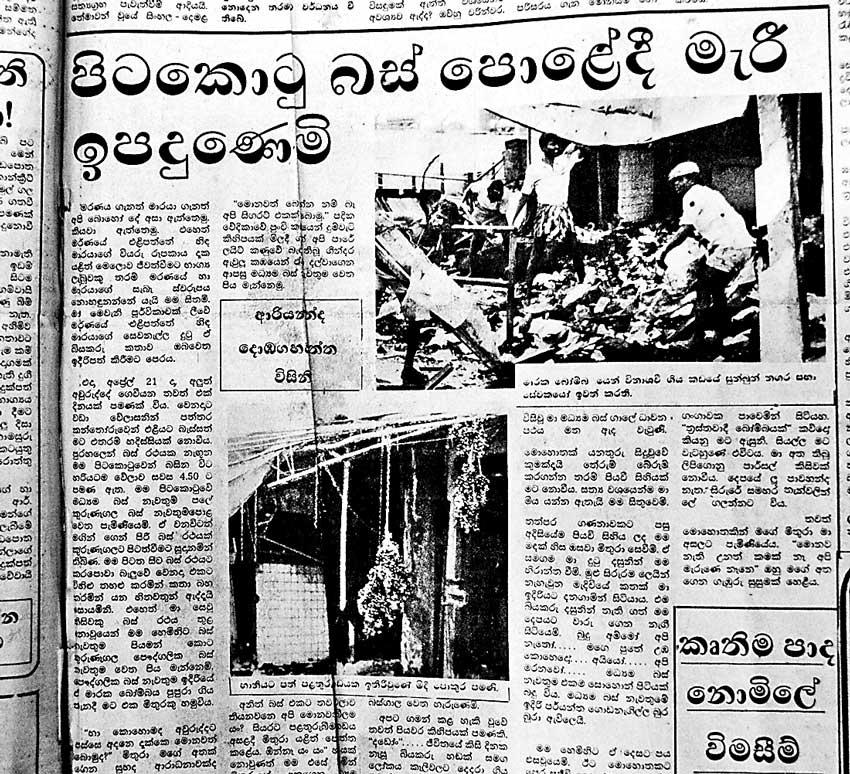
මියගිය අයගේ අවසන් කටයුතු සඳහා එක් අයෙකුට රුපියල් 2500 මුදලක් ලබාදීමට කටයුතු කර තිබිණි.
ජීවිත හානිවලට අමතරව මේ සිදුවීමෙන් පිටකොටුව පෞද්ගලික බස් නැවතුම්පළෙහි නතර කොට තිබූ දුර බැහැර පළාත්වලට යන මගීන් පුරවාගත් පෞද්ගලික බස්රථ 11 ක් සම්පූර්ණයෙන් විනාශ වී තිබිණි. ඒ හැරුණු කොට බස් නැවතුම්පළත් පිටකොටුව බෝධියත් අතර මාර්ගයේ නතර කොට තිබූ වාහන රැසක් විනාශ විය.
ලංකා බැංකු ශාඛාව ඇතුළුව එම ගොඩනැගිල්ලෙහි වූ සියලුම කඩසාප්පු විනාශ වී තිබිණි. ඒවායේ සේවය කළ පිරිස් ද මිය ගොස් ඇත.
මෙම පිපිරවීම කර ඇත්තේ ඊරෝස් ත්රස්තවාදී සංවිධානය බව ජනමාධ්ය මගින් නිවේදනය විය. එල්ටීටීඊ යට සහය දක්වමින් ඊරෝස් සංවිධානය විසින් මෙය සිදුකර ඇති බව ද සඳහන් විය.
පිපිරී ගිය මෙම බෝම්බය කාල බෝම්බයක් වන අතර එය කිලෝ 60ක් පමණ බරකින් සමන්විත වූ බවද පැවසේ.
මේ සිදුවීම සම්බන්ධයෙන් සැකපිට දෙමළ ජාතික තරුණයන් දෙදෙනෙකුද පොලිසිය විසින් අත්අඩංගුවට ගන්නා ලදී. බෝම්බ පිපිරීමෙන් තුවාල ලැබූ මේ දෙදෙනා ඇඳිරි නීතිය පවතින අතරතුර මීගමුව බලා යාමට උත්සාහ කර ඇති අතර ඒ පිළිබඳව සැකසිතී ටැක්සි රියැදුරෙකු විසින් ඔවුන් දෙදෙනා අල්ලා පොලිසියට භාර දී තිබිණි.
මෙම සිද්ධිය පිළිබඳව පොලිසිය 160 දෙනෙකුගෙන් ප්ර්රශ්න කර තිබූ අතර මොවුන්ගෙන් වැඩි දෙනෙකුට හැඳුනුම්පත් පවා තිබී නැත.
මොවුන්ගෙන් වැඩි පිරිසක් දමිළ තරුණයන් වූ අතර මේ පිරිස කොළඹ නගරයේ ඇතැම් හෝටල්වල සහ කඩකාමරවල නිවෙස්වල නවාතැන්ගෙන සිටිය දී අත්අඩංගුවට ගෙන තිබේ.
බෝම්බ ප්රහාරයට ලක්වූ දින දෙමළ වෙළෙඳසල් පස්වරු 4 ට පමණ වන විට වසා දමා ඇති බවත් බොහොමයක් ආයතනවල දෙමළ සේවකයන් එදින වරුවක් නිවාඩු දමා ගොස් ඇති බවත් ඒ පිළිබඳ විශේෂ පරීක්ෂණ පවත්වන්නට රහස් පොලිසියට සිදුවූ බවත් පැවසේ.
අවසානයේ මෙම ප්රහාරය ගැන කරුණු සොයා බැලූ පොලිසියට දැනගත හැකිවූයේ බෝම්බය රැගෙන පැමිණි තරුණයන් හතරදෙනා කොටහේන බෝඩිමක නවාතැන්ගෙන සිටි බවය. බෝම්බය ඇට වූ ෙෆා්ඩ් එස්කෝට් රථය මේ තරුණයන් පදවාගෙන පැමිණ ඇත්තේ මඩකළපුවේ සිට බව ද අනාවරණය විය.
එදින බස් නැවතුම්පළේ සිටි සියලුම මගීන් තම තමන්ගේ නිවෙස්වලට යැවීම සඳහා හැකි සෑම පියවරක්ම ගත් බවත් හදිසියේම පැනවූ ඇඳිරි නීතිය පවා නොතකා අවසන් මගියා දක්වා පිටත්කර යවන තෙක් සියලුම සේවක මහත්වරු දැඩි උනන්දුවකින් යුතුව කටයුතු කළ බවත් සඳහන්ය.
ඇඳිරි නීතිය ඉවත් කිරීමත් සමග බෝම්බ පිපිරීමෙන් පසු සිදුවූ විනාශය දැකබලා ගැනීම සඳහා දස දහස් සංඛ්යාත පිරිසක් පිටකොටුවට ඇදී එන්නට වූහ. වැල නොකැඩී එන දහස් සංඛ්යාත පිරිස හැසිරවීම සඳහා සිය ගණනක් පොලිස් භටයෝ රැකවලෙහි නිරතව සිටියහ.
මෙම මහා ඛේදවාචකයෙන් කම්පාවට පත්කරමින් දෝ එදිනම ඇද හැළුණු ධාරානිපාත වර්ෂාව නිසා පිටකොටුව හරහා ගලා ගිය මහා රුධිර ගංගාව ද සේදී ගියේය. බෝම්බ පිපිරවීමට සිදුවූ අවට ප්රදේශය ලණු ඇද වෙන්කර තිබිණි.
බෝම්බ පිපිරුණු තැන හෑරී තිබූ අඩි 3 ක පමණ වළද පරීක්ෂණ කටයුතුවලින් පසු කොන්ක්රීට් කැබලි දමා වසා ඇත. මීට වසර 32 කට පෙර සිදුවූ මෙම ප්රහාරය පිළිබඳ බොහෝදෙනා අදටත් කතා කරති. තර්ක විතර්ක කරති. ත්රස්තවාදයටත් ත්රස්තවාදීන්ටත් ශාප කරති.
ජනමාධ්ය වාර්තා ඇසුරින්
සටහන ධනු විජේරත්න
The terror war waged by the LTTE
The terror war waged by the LTTE for more than three decades took a heavy toll on civilians. Innocent civilians, including women, children, the elderly and the clergy were hacked to death and killed in indiscriminate terrorist blasts and raids.
The number of people killed in this senseless armed struggle waged by the LTTE exceeds more than 100,000 in terms of a conservative estimate. There is no proper estimate as to how many people were wounded or mentally traumatized.
The Sunday Times has prepared a chronology of events highlighting some of the most barbaric attacks on civilians and assassinations of Tamil politicians, intellectuals and government officials. On this list of terror victims were two state leaders — President Ranasinghe Premadasa and Indian Premier Rajiv Gandhi.
In some of the attacks targeted at politicians, it was the civilians who were killed while in other attacks several civilians also died along with the politician or military officials the Tigers targeted. The chorology also includes some of the attacks on economic targets.
Tamil politicians and officials assassinated by the LTTE
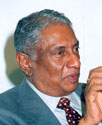 |  |  |  |  |
| Lakshman Kadirgamar | Neelan Thiruchelvam | A Thangathurai | A T Duraiyappah | A Amirthalingam |
2005 August 12: Minister of Foreign Affairs Lakshman Kadirgamar assassinated in Colombo.
1999 July 29: Dr. Neelan Thiruchelvan, TULF MP
1998 September 11: Ponnuyhurai Sivapalan, Jaffna Mayor
1998 May 16: Sarojini Yogeswaran, TULF Mayor of Jaffna
1997 October: S.P. Dharmalingam, SLFP organizer for Jaffna
1997 July 5: A. Thangathurai, TULF MP for Trincomalee
1990 June 19: K. Pathmanabah, Leader of EPRLF (together with all but one member of the party’s politburo)
1990 June 19: V Yogasangari, EPRLF MP in Madras
1990 May 7: Sam Thambimuttu, EPRLF MP and his wife.
1990 January 28: Ganeshalingam, ex EPRLF Provincial Council Minister for North and East
1990 January 28, Dr. (Mrs) Rajini Thiranagama , Human rights activist and lecturer in Anatomy at the University of Jaffna and Co-author of the book ‘Broken Palmyrah”
1989 July 16: PLOTE leader Uma Maheswaran
1989 July 13: V. Yogeswaran, ex-TULF MP for Jaffna
1989 July 13: A. Amirthalingam, Leader of the TULF
1989 June 28: K. Pullendran, Assitant Government Agent, Kopay
 |  |
| Rajini Thiranagama | Uma Maheswaran |
1989 May 1: V.M. Panchalingam,Government Agent, Jaffna
1989 March 7:S. Samabandamoorthy, ex-TULF chairman, District Development Council, Batticoloa
1988 October 27: Raj Shankar, President, Citizen’s Committee, Tennamarachchi
1988 June 6: Rev. Fr. Chandra Fernando, President, Citizen’s Committee, Batticoloa
1988 March 28: Velmurugu Master,TULF organizer and Citizen’s Committee member, Kalmunai
1988 March 8: S. Wijeyanandan, District Secretary, Ceylon Communist Party
1988 January 13: S. Siththamparanathan, principal, Wigneswara Vidyalaya, Trincomalee
1987 December 14: M.E. Kandasamy, Principal, Palugamam Maha Vidyalaya
1987 October 8: S.S. Jeganathan, Assistant Government Agent, Batticoloa
1987. October 8: Anthonimuttu, Government Agent, Batticaloa
1987 September 15: Vignarajah, Assistant Government Agent, Sammanthurai
1986 May 6: TELO leader Shri Sabaratnam in Kondavil Jaffna
1986 September 26: Kathiramalai, Sarvodaya leader
1986 March 11: P. Kirubakaram , Primary Court Judge
1985 September 2: Alalasunderam, ex-TULF MP for Kopay
1985 September 2: V. Dharmalingam, ex-TULF MP for Manipay and father of D. Siddharthan, Leader of PLOTE
1985 August 22: P. Thambipillai, president, Citizen’s Committee Oddusudan
1985 June 26: C.E.Anandarajah, Principal St. John’s College, Jaffna.
1985 February 24: Gnanachandiram, ex District Judge, Point Pedro and Government Agent, Mullaitivu
1983 September 1: Mala Ramachandran, UNP MMC for Batticoloa
1983 August 12: A.J. Rajasooriya, UNP organizer for Jaffna
1983 January 19: K.T. Pulendran, UNP organizer for Vavuniya
1981 May 25: Member of Parliament of the Vaddukoddai electorate A. Thiyagaraja
1975 July 27: Jaffna Mayor, Alfred Duraiappah.
Brutal civilian massacres
2009 April 22: Sixteen civilians were killed in Karametiyawa, Inginiyagala.
2008 February 03: At least seven people died and 97 were injured in a suicide bomb attack at the Fort Railway station.
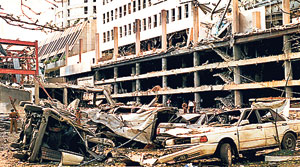 |
| Central Bank blast |
2008 June 06: Twenty one passengers died in a claymore attack on a bus in Katubedda Moratuwa.
2008 April 25: Twenty four civilians were killed in a parcel bomb explosion inside a bus in Pliyandala
2008 January 16: Twenty seven passengers perished in an attack on a bus in Buttala.
2007 November 28: Seventeen civilians were killed and 37 injured in a parcel bomb explosion at a Nugegoda shop.
2007 January 06: Fifteen civilians were killed and 40 wounded in a parcel bomb explosion inside a bus at Seenigama, near the Kahawa junction, Galle.
2006 July 15: Sixty seven passengers were killed and 90 injured in a claymore mine attack on a bus in Kebithigollewa.
2006 April 23: Six farmers were killed in the Polonnaruwa district
2006 May 29: Thirteen labourers were killed in the Polonnaruwa district
2001 July 24: Attack on the Bandaranaike International Air Port. Twelve people died and 13 aircraft destroyed.
2000 October 5: At least 12 persons were killed and more than 40 wounded when an LTTE suicide bomber blew himself up in an attempt to enter a PA election rally.
2000 March 10: At least 14 civilians and six police personnel were killed and 46 people were injured when a group of five suicide cadres attacked a motorcade on the road to Parliament at Rajagiriya.
2000 January 5: A female suicide bomber exploded herself while she was being body searched by Police near the Prime Minister’s Office in Colombo. Thirteen civilians and three police officers were killed and 27 people wounded in the blast.
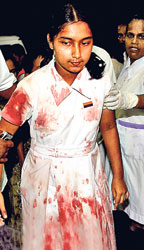 |
| Piliyandala bus blast |
1999 December 18: A suicide bomber, detonates a bomb strapped to his body, killing retired Major General Lakshman Algama and 11 persons at a United National Party (UNP) election rally at Ja-Ela in Colombo.
1999 September 18: Fifty civilians were killed in an attack in Gonagala.
1998 March 5: Thirty-six civilians and two police officers were killed and 270 civilians wounded when a mini-bus, filled with explosives, was blown up by a suicide bomber near the Maradana Police Station in Colombo.
1998 February 23: At least 51 troops and 28 civilians were killed in a suicide attack on the Point Pedro coast when eight Tiger boats laden with explosives crashed into two navy ships.
1998 January 25: A suicide bomber blasted a lorry-laden with explosives at the Dalada Maligawa. Sixteen persons were killed while extensive damage was caused to the Maligawa, a cultural heritage site recognised by the UNESCO.
1997 October 15: Suicide bombers detonated a truck packed with explosives in the parking lot at Galadari Hotel close to the World Trade Center in Colombo, killing 18 people and injuring at least 110 others.
1996 July 24: Bomb explosion on Colombo-Alutgama train at Dehiwala killed 60 civilians.
1996 April 18: The naval wing of the LTTE, Sea Tigers, launched a suicide raid on the port of Colombo. Nine LTTE cadres were killed when the troops blew up their boats.
1996 January 31: A suicide bomber detonated a truck loaded with more than 100 kilograms of explosives in front of the Central Bank in Colombo killing 91 people and wounding at least 1,400 others.
1995 November 24: Sixteen civilians were killed and over 50 injured when two women suicide cadres targeted the Army headquarters.
1995 November 11: Seven persons including 15 children were killed when a female suicide bomber exploded herself near the Kompannaveediya Railway Station in Colombo.
1995 October 26: Twenty six villagers were killed in Kebithigollewa.
1995 October 21: Sixty six villagers were killed in attacks in Ampara, Polonnaruwa and Anuradhapura.
1995 August 7: A male suicide bomber set off a cartload of explosives at Independence Square in Colombo, killing 22 people and injuring more than 40 others.
1995 May 25: Forty two civilians were massacred in Kallarawa.
1992 October 15: Massacre of 146 Muslim civilians in Palliyagodella.
1992 April 29: Some 130 Muslim civilians were massacred in the Alanchipothana village in the east.
1990 August 3: An LTTE gang killed 103 civilians in Kathankudy.
1987 July 02: The massacre of 32 Buddhist monks at Aranthalawa.
1987 April 21: One hundred and fourteen civilians killed in a bomb explosion near the Pettah bus stand in Colombo
1986 May 30: An explosion at Ceylon Cold Stores in Kompannaveediya killed eight civilians and wounded 22.
1985 May 14: The LTTE carried out an attack on the Jaya Shri Maha Bodhiya in Anuradhapura, killing 120 civilians. The attackers while they were fleeing also killed 18 civilians in Wilpattu.
1984 Nov. 30: Sixty two civilians were killed in attacks on the Dollar and Kent Farms
1976 July 02: A fuel station manager, S. Nadaraja, was shot dead as he was believed to be an army informant.
Tamil militancy: The beginning
 |
The Tamil Youth Front (TYF) was formed through the initiative of the leader of the Tamil United Liberation Front (TULF) A. Amirthlingam for the purpose of assisting the then Tamil United Front (TUF). On a statement given to the Police by S.Pushparaj one of the two youth leaders instrumental in the formation of the TYF, their assistance was to include assistance through voice.
Later Pushparaj and his loyalists, unhappy with the TUF’s non committal support towards violence as a means to achieve their ends, broke away and formed a splinter Ela Viduthalai Eyakkam (the Tamil Eelam Liberation Organisation) – the TELO. Several other members of the TYF then also discarded whatever democratic approach they had. They went onto form more militant organizations such as the Tamil New Tigers (TNT), and the Liberation Tigers of Tamil Eelam (LTTE).
Some of the terrorist incidents where foreigners were killed
 |
| Former Indian Prime Minister Rajiv Gandhi |
2003 March 20: Attack and capture of Chinese “Shu- Yun” trawler- 20 of the ship-crew died. 1991 May 21: Former Indian Prime Minister Rajiv Gandhi and 17 Indians were killed in South India.
1987 -1990: More than 1,000 Indian Peace Keeping soldiers died in northern and eastern provinces of Sri Lanka.
1986 May 3: Thirteen foreigners were among 16 people killed when the terrorist exploded an Airlanka Tristar plane at Katunayaka.
1984: Forty passengers were killed in bomb explosion at the Chennai airport.
Politicians killed by the LTTE
In many of these attacks a large number of civilians were also killed. 2008 October 06: More than 25 civilians, including Maj Gen Janaka Perera, were killed in an LTTE suicide bomb attack in Anuradhapura
2008 April 06: Minister Jeyaraj Fernandopulle and 12 others were killed in an LTTE suicide bomb attack in Weliweriya.
 |  |  |  |  |
| Janaka Perera | Jeyaraj Fernandopulle | Gamini Dissanayake | Ranjan Wijeratne | R Premadasa |
2000 June 7: A suicide bomber killed Minister C. V. Gooneratne and 24 civilians whilst he was in a procession organised to mark ‘war heroes’ day at Golumadama Junction in Ratmalana.
1995 May 26: The chief incumbent of the Dimbualagala temple Ven Kithalagama Shri Seelalankara thera was killed.
1994 October 24: Opposition leader and United National Party presidential candidate Gamini Dissanayake and 58 persons, including several senior politicians, were killed by a female suicide bomber at Thotalanga in Colombo.
1993 May 1: President Ranasinghe Premadasa and 23 others were killed by a suicide bomber in Colombo.
1991 May21: A female suicide bomber killed India’s former Prime Minister Rajiv Gandhi while he visited the southern Tamil Nadu state for an election rally at Sriperumputhur.
1991 March 2: Deputy Defence Minister Ranjan Wijeratne and 18 people were killed in a blast at Havelock Road in Colombo.
The sequence of major events weeks before the 1983 July riots
1983 June 1: Murder of two airmen at Vavuniya when a hand-bomb was thrown inside a jeep. The Vavuniya police had arrested some of the guerrillas believed to have been from the Uma-Maheswaran led PLOTE.
1983 June 4: Murder by shooting of S. Tilagar, a candidate of the recent local government elections.
1983 June 9: An unidentified body found, shot in the head, believed to be another summary execution, in Point Pedro.
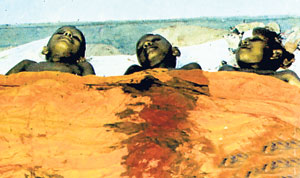 |
| Aranthalawa blast |
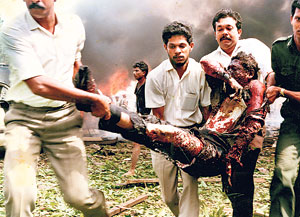 |
| JOC blast |
1983 June 11: Three similar unidentified bodies found at Mankulam.
1983 June 16: Army mobile patrol shot at in Nallur
1983 July 1: Attempted burning of a state bus at Kulappidi Junction.
1983 July 1: Burning of the “Yal Devi”, the 10-carriage Colombo-Jaffna express.
1983 July 1: Burning of a state bus at Puttur junction.
1983 July 2: Burning of a state bus at Nelliady Town.
1983 July 3: Burning of state bus at Vaddukkodai junction.
1983 July 5: Attack on Post office in Jaffna.
1983 July 6: Attack on cement factory at Kankesanthurai.
1983 July 6: Unknown youths held the Additional Government Agent, three male clerks, two female clerks and two others at gun point at Thinnaveli and smashed up office equipment before leaving. They also dashed the photographs of the President, the Prime Minister and the Tamil Home Minister on the road outside. They left a bomb behind which was defused by the Army.
1983 July 7: Damage caused to Suthumalai Post Office.
1983 July 8: Burning of a state bus at Chettikulam.
1983 July 9: Damage caused to Inuvil Post office.
1983 July 23: Ambush of one officer and 12 soldiers of the Army at Thinnaveli which sparked off the intense rioting in the South.
Failed attacks on political and military targets – with civilian casualties
In some of the attacks targeting military officials or politicians, the LTTE missed the target, but a large number of civilians were killed. Following is a list of such attacks.
2009 March 10: Minister Mahinda Wijesekara was seriously injured in a suicide bomb attack at the National Meelad Festival in Akuressa. Ten civilians were killed and 60 others wounded in the blast.
2008 October 09: Minister Maithripala Sirisena survived an LTTE suicide attack at Katuwawala in Piliyandala, but five civilians died.
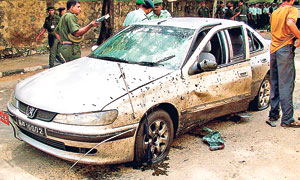 |
| Bomb blast attempted at Army Commander |
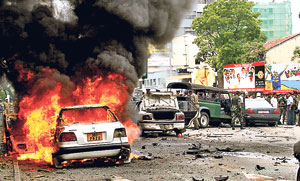 |
| Piththala Handiya blast aimed at Gotabhaya Rajapaksa |
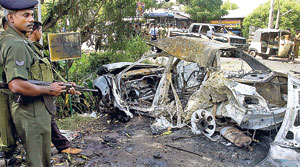 |
| Pannipitiya blast which killed Deputy Chief of Staff of the Army, Major General Parami Kulathunga |
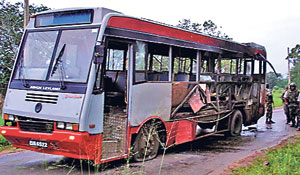 |
2007 January 28: A female LTTE suicide bomber targeting Eelam People’s Democratic Party (EPDP) leader and Social Services Minister Douglas Devananda blew herself up. The minister escaped but the blast killed his Public Relations Officer.
2006 December 01: Defence Secretary Gotabhaya Rajapaksa escaped an LTTE suicide attack in which six people, including his bodyguards, were killed.
2006 August 14: In a suicide blast targeting the then Pakistani High Commissioner Bashir Wali Mohammad seven people died.
2006 April 25: Army Commander Sarath Fonseka was wounded in a suicide blast inside the Army headquarters. The attack was carried out by an LTTE female cadre who posed off as a pregnant woman. Nine people, including civilians, were killed.
2001 October 29: Prime Minister Ratnasiri Wickremanayake escaped an assassination attempt when police intercepted a would-be suicide bomber who detonated explosives strapped to his body, killing himself and five others.
2004 July 07: In Colombo, five policemen were killed when a suspected LTTE woman suicide bomber blew herself up inside the Kollupitiya police station after she was arrested at Minister Douglas Devananda’s office.
2000 September 15: Seven people were killed and 28 others sustained injuries when a suicide bomber, on being detected, blew himself up. Health Minister Nimal Siripala de Silva had a narrow escape as he had passed through the site barely seven minutes before the blast.
December 18, 1999: President Chandrika Kumaratunga was wounded and 21 were killed and more than 100 people injured at a presidential election campaign rally in Town Hall, Colombo.
1997 December 28: Three suicide bombers died when their truck exploded half a mile from the Magalle naval base in the Galle District where Navy Commander Cecil Tissera was staying. Ten shops and two houses were damaged.
1996 July 4: At least 20 people, including Jaffna military commander Brig. Ananda Hamangoda, were killed and 60 injured when a female suicide bomber blew herself up. Minister Nimal Siripala de Silva escaped with minor injuries.
What is the reason for the decline of Sinhalese in the northern and eastern provinces of Sri Lanka?
The depopulation of the Sinhalese people in the Dry Zone of Sri Lanka began before the arrival of the British and continued into the early 20th century. This process was facilitated by a number of factors, including economic and political policies that favored the settlement and development of the more populous coastal regions, at the expense of the sparsely populated interior. Tamils and Muslims from these coastal regions migrated to the Dry Zone in search of land and opportunities, leading to a change in the ethnic makeup of the area.
At the same time, there was a process of assimilation occurring in the Dry Zone, as Sinhalese living in isolated settlements or among Tamil communities were increasingly absorbed into the Tamil community. This process was facilitated by the British, who used Tamils over Sinhalese in government positions in these areas, and the fact that Tamil was the language of instruction in schools and the language spoken by court interpreters and petition drawers. As a result, many Sinhalese in the Dry Zone lost their cultural traditions and became “Tamilized.”
These changes in the ethnic makeup of the Dry Zone had significant consequences, including the marginalization of the Sinhalese in these areas and the erosion of their cultural traditions. This has led to ongoing tensions and conflicts between the Sinhalese and Tamil communities in Sri Lanka. It is important to recognize and address these issues in order to properly understand the history and identity of Sri Lanka as a nation.
SRI LANKA: THE UNTOLD STORY
| South Asia |
| SRI LANKA: THE UNTOLD STORY Chapter 55: Assassination of Athulathmudali By K T Rajasingham In the 1989 presidential elections, Lalith Athulathmudali, who was then the Minister for National Security, Prime Minister Ranasinghe Premadasa and the Minister for Mahaveli Development, Gamini Dissanayake, were widely believed to be the contenders for nomination from the ruling United National Party (UNP). But Premadasa was nominated, and he won the presidential elections to become the country’s second executive president, succeeding J R Jayewardene. Subsequently, Athulathmudali and Dissanayake were believed to be the contenders for the post of Prime Minister. But Premadasa overlooked both of them and nominated D B Wijetunge. Furthermore, Premadasa took away from Athulathmudali the important portfolio of National Security and nominated Ranjan Wijeratne as Minister of State for State Securities, as he has helped him to secure the UNP nomination for the presidential elections. Athulathmudali and Dissanayake, who had been powerful ministers and very influential personalities in the J R Jayewardene government, were progressively deprived of their powers and influence by Premadasa. Athulathmudali was appointed Minister of Agriculture and Cooperatives and later Minister of Education and Higher Education. Dissanayake, who was appointed initially as the Minister of Plantation Industry, was stripped of this portfolio in the March 1990 reshuffle. Earlier, during the parliamentary general elections held in February 1989, Premadasa supported his lieutenant, Srisena Coorey, against Athulathmudali for the position of Chief Organizer of the UNP for the Colombo District. In the elections, Athulathmudali won the highest number of preferential votes cast all-island – 235,447 – and also came first in the number of preferential UNP votes cast in the Colombo District. Whereas Srisena Coorey polled 92,236 votes and came a poor second. After the parliamentary elections, Athulathmudali once again became the Chief Organizer of the UNP of the Colombo district. On March 2, 1991, the Deputy Minister of Defense and the General Secretary of the UNP, Ranjan Wijeratne, was killed, and Premadasa appointed Srisena Coorey as the General Secretary of the UNP, without consulting the working committee or other senior leaders of the party. Also, premier D B Wijetunge was appointed as Deputy Defense Minister. However, primary party elections were held a few weeks later and Athulathmudali’s position as district leader was undermined by Srisena Coorey, who took over primary election matters for the Colombo Municipal Council. Earlier in this series, in chapters dealing with the assassination of Lieutenant-General Denzil Kobbekaduwa, the secret transfer of weapons to the Liberation Tigers of Tamil Eelam (LTTE) by President Premadasa was outlined. Also, the evidence given by the army deserter turned witness Vathiyage Visva Kumara has been extensively discussed in the chapters dealing with the Commission of Inquiry into the assassination of Kobbekaduwa and nine others at Araly Pont, Kayts on August 8, 1992. Superior officers of the army, Special Task Force (STF) and persons who held executive and administrative positions in Premadasa’s government, namely General Sepala Attyagalle, Secretary of Defense, K H J Wijedasa, Secretary to the President, Brigadier Bohoran of the army, Lionel Karunasena and Sahabandhu and Commandant and the Deputy Commandant of the STF and a host of other officers have all admitted and confirmed both in their testimony of the witness Vathiyage, to the fact that arms and ammunition, including 6mm RPG guns, motars, self loading rifles, 400 T81 automatic rifles, T56 automatic rifles, pistols, hand grenades, ammunition and equipment for all communications sets etc and other components of modern warfare were given to the LTTE. Tear gas rifles, tear gas, signal flames, pistols, fingercups, etc and hand-held integrated circuits, SG 700 car antennas, video cassettes, boot mounts, tilting boot mounts pipe mounts etc were also passed on. Furthermore, the LTTE ordered the import of numerous items, such as well drilling machines, radios, cables, mobile sets, head phones, microphones, batteries, amplifiers and water purification tablets which were imported and addressed to Defense Secretary General Sepala Attyagala, c/o A S Balasingham of the LTTE. The duty on these imported items was paid by the Defense Ministry. Money was also secretly given to the LTTE in 1989 and in 1990. Weapons were given from Government stocks, from armories, specially imported for the purpose of usage of the air force, army, navy and STF on the orders of the President, ostensibly to crush the Tamil National Army, thought to be fostered by the Indian Peace Keeping Force (IPKF), and through that the IPKF was able to read the intentions and the signals of the Sri Lankan Government and would leave the country. As an aftermath of the transfer weapons by the Government to the LTTE in 1989-1990, a Presidential Commission in its Sessional Paper No. VIII – 1997 reports as follows: (a) The Indian Peace Keeping Forces leave Jaffna on 20th March 1990 (The date they left the shores of Sri Lanka was 24 March 1990) and returned to India a few days later, after licking their wounds. They had been asked to leave by President Premadasa in mid 1989. Towards the end of May 1990, the outstation reports showed the LTTE were taking control of more and more territory. (b) Premadasa was insistent that the IPKF leave Sri Lanka. The LTTE while crushing the TNA emerges as a resurgent domineering force in the North and East. They demand the withdrawal of army camps in the North and East and the withdrawal of the police in those areas. The IPKF have left. The LTTE takes up police duties. They did inquiries into complaints. They manned road blocks and policed the roads. Government forces were humiliated on public roads. The police are mostly confined to their station premises attending to minor duties, such as attending to cases of sudden deaths, accidents and insurance. Police officers played games and guarded themselves. To leave the police station, the police had to telephone and get permission from the LTTE. Armed LTTE cadres used to come into police stations to talk to the OIC. The LTTE used to walk about the roads armed with sophisticated weapons. The LTTE conducted its own training programs. The Army camp at Akkaraipattu was withdrawn. At instruction classes, police were told there were peace talks between the LTTE and the Government for the development of the country and the police were told not to clash with them. (c) On 11 June 1990, the LTTE surrounded the police stations in the Batticaloa and Amparai police divisions and asked the police to surrender and they would transport them to Amparai. The Government asked the police to act with restraint. Some police officers were prepared to hold their and fight and requested Artillery and Air support. Later that day IGP (Inspector General Police) informed that such a support was not available. President Premadasa did not know what to do. He has been kept informed right along what was happening since May. He had believed the LTTE and now he felt let down – that was the evidence of Mr. K.H.J. Wijedasa, Secretary to the President. The police were asked to surrender. They did so believing that they would be transported to Sinhala areas. In some stations LTTE opened fire and police officers were killed. The LTTE entered all stations breaking open the gates and fences, broke open the armories and took all weapons and ammunitions. In the Amparai district the police officers were herded into vehicles and then taken to Kanchikudicahiaru jungles and shot dead. One person who survived the ordeal and who escaped has testified before the Commission. P S A L Najubudeen was acting OIC of Akkaraipattu police at that time. He gave a detailed account of what happened on June 11, 1990 and how they were betrayed and taken into thick forest and shot and his escape etc. The Commission believed him. His evidence was not been contested in any manner. He later led the authorities to the spot where the others were shot death. The real evidence there confirmed his death. Meanwhile, after the displeasure between Premadasa and Lalith Athulathmudali surfaced, President Premadasa at public meetings spoke of “learned fools” to wit and spoke of “learned men who robbed cleverly but also went to jail”. There were obvious references to allegations of wrong doing made against Lalith Athulathmudali in regard to ships and shipping, whilst being in charge and leveled during the general election campaign, and of his being remanded in custody in 1976 in respect of a conspiracy to cause grievous hurt to Ediriweera by means of corrosive substance to wit: acid and abatement of that offence which was committed. Lalith Athulathmudali spent time in the remand jail during the police investigations. Meantime, Luxman Perera, Member of the Municipal Council (MMC) wrote a play using the title “Me – caudate – Monawada Karanne?” (The Sinhala translated into English: Who is he – What is he doing?) This title has been taken from the slogan of the same words used in the 1988, in support of President Premadasa’s presidential election campaign. Luxman Perera’s drama was meant to be a satire on the Premadasa’s administration. Luxman Perera joined hands with journalist and media man Richard Soyza. Luxman Perera’s play was submitted to the Public Performances Board, which approved it. It was said that, Lalith Athulathmudali was aware of the content of the drama, as Luxman Perera was one of his close political associates. Luxman Perera lived in a bungalow belonged to the Railway Department, in the Station Road, Dehiwala, with his family. Lalith Athulathmudali agreed to be the chief guest of the drama, on the opening night. Suddenly, a few days before the opening night, a van without a number plate arrived at Luxman Perera’s home at night and took him away. He disappeared. He was presumed dead. It was rumored that Senior Superintendent of Police (SSP) Ronnie Gunasinghe was responsible for the abduction. A few days later, on February 18, 1990, Richard Soyza was forcibly carried away from his bed, by a group of men, who arrived at about 3 am, despite his mother’s protest and intervention. Subsequently, Richard Soyza’s body was found washed ashore at Korolawella beach Moratuwa. These were the beginning symptoms of Lalith Athulathmudali’s troubles in the UNP. When the episode regarding the impeachment motion was staged, Lalith Athulathmudali was sacked from the UNP. The theme of depicting President Premadasa as being unsound mind in the impeachment motion was said to have originated from the play written by Luxman Perera. Premadasa referred to Lalith Athulathmudali as a “Ugath Modaya” – Learned Fool – because he was deeply insulted by the wording of “unsound mind” in the impeachment motion. The impeachment motion against the President was given to the Speaker on August 28, 1991. It was reported that, at that point of time, Lalith Athulathmudali had not signed those papers, whatever was given to the Speaker. The Speaker communicated with the President about the impeachment motion. Premadasa then sought a vote of confidence from the Cabinet on that day. Lalith Athulathmudali and Premachandra were present and they voted with the other Cabinet colleagues, expressing confidence in the President. On August 29, 1991, Athulathmudali and Premachandra both resigned their ministerial portfolios. On August 30, Athulathmudali, Premachandra and Gamini Dissanayake were sacked from the UNP by the Working Committee of the Party. The President prorogued parliament on the same day and the two ministers and others filed action in the District Court challenging their expulsion from the party. But they failed at the District Court and they filed the same petition in the Supreme Court, and there too their action failed and the dismissal from the party was upheld. Subsequently, Athulathmudali and Dissanayake and others, who were dismissed from the party, began to organize public meetings all over the country, to explain what had happened and to inform the public of the content of the impeachment motion against the President. Also in the public meetings, speaker after speaker alleged the mental infirmity of the President and the conversion of the democratic constitution into a “One Man Show”. These developments marked a watershed in the political lives of Athulathmudali, Dissanayake and Premachandra. All security given to these ministers was withdrawn by the government. On August 30, 1991, the government withdrew the 12 security officers of Athulathmudali, but later he was given two back. Athulathmudali, Dissanayake and others organized themselves into a political opposition to the Government of President Premadasa. They set about broadcasting the content of their resolutions against the President in numerous ways. They held their first public meeting against the Government on August 10, 1991 at Nugegoda. Prior to this, Athulathmudali received information that the meeting was to be attacked and he complained to Henry Perera, SSP in charge of the Nugegoda division, on the night of August 9. It was later learnt that the written complaint made by Lalith Athulathmudali spoke of a conspiracy to disrupt the meeting on the 10th and kill him. It was further revealed that the complaint carried the names of the conspirators and vehicle numbers. Henry Perera took all necessary security precautions for the public meeting, which commenced at 3.30 pm on August 10. The crowd was estimated at about 200,000. Lalith Athulathmudali addressed the meeting at 7 pm. Besides the big meeting at Nugegoda, several pocket meetings were organized in private premises, which were held island-wide and at which Athulathmudali would speak for nearly 10 to 15 minutes and then stage a question and answer session for an hour or so. Meanwhile, on November 28, 1991, an application to register the Democratic United National Front (DUNF) was made. Athulathmudali joined the party on December 3, 1991. The party was registered as a political party on January 20, 1992. In 1992, Athulathmudali was elected leader of the party. On November 2, 1991, a public meeting was held at the playground at Pannala. Athulathmudali, Dissanayake, Premachandra and others addressed the meeting. It commenced at 5 pm and about 100,000 to 150,000 people were seen gathered. At about 6.30 pm, while Premachandra was speaking, a bomb exploded nearly 10 to 15 feet away from the stage, but the police recorded it as a bomb exploding 50 feet away from the stage. Two persons were injured. Unfortunately, no arrests were made in connection with the bomb blast. Athulathmudali demanded an inquiry but nothing came out of the police inquiry. A meeting was scheduled to be held at Waidya Road, Dehiwala on April 2, 1992, but it was abandoned because thugs destroyed the stage and assaulted Athulathmudali’s supporters. On the following day, the DUNF party organizer for Dehiwala’s house was attacked and property destroyed, also his wife was attacked by thugs, allegedly supporters of President Premadasa. Again, another important and serious incident happened at the Fort Railway Station on August 7, 1992, when Athulathmudali and Dissanayake and other DUNF supporters were at the station in the morning, collecting signatures from the public to commemorate the first anniversary of the motion to impeach the President. The DUNF leaders, accompanied by numerous supporters, photographers and journalists, arrived at the station at about 6.30 am to meet the public commuting to work by train and to obtain their signatures of approval to commemorate the first anniversary of the impeachment motion in an effort to impeach Premadasa in terms of the relevant article of the constitution. The first anniversary was due on August 28, 1992. Suddenly, armed thugs entered the station from the road side and began to attack the DUNF supporters with weapons. A press photographer’s camera was snatched and a man brandished a knife at Athulathmudali, who raised his arms and cried for help. When the DUNF supporters saw the situation they came running towards Athulathmudali. Sensing the mood of the supporters, the attacker with the knife ran away and got into a moving train and disappeared. Athulathmudali and the DUNF party men went to the Fort police station to make complaints. Lakshman Wijeratne, Assistant Superintendent of Police (ASP) came out of the police station and said, “The police station is closed.” Another mishap happened on August 29, 1992, when the DUNF was involved in a membership drive at Kawdana, Dehiwala. About 50 to 60 DUNF supporters and members were present when, according to one report, Clement Perera, one of the lieutenants of Athulathmudali, saw a maroon Peugeot 505 car go slowly passed. Perera recognized Vasantha Weerasekera, an employee of Susil Jayasinghe, the Mayor of Dehiwala -Mount Lavania, seated in the vehicle. Immediately he realized that there may be trouble and he went and told Athulathmudali, who told Perera not to tell others as they could get excited. Thereafter, Athulathmudali and his supporters started walking along Palliyodara Road, visiting houses and speaking to people and enlisting new members for the DUNF. While this was going on, they saw a group of people walking towards them with cricket bats, baseball bats, sticks, clubs, iron rods and pipes. They went up to Athulathmudali and started assaulting him. One person brandished a pistol, but before any harm was done, Athulathmudali kicked him. Another beat Athulathmudali with a club on his legs. Even Athulathmudali’s security officers received blows. Subsequently, the assailants ran away towards Dehiwala police station. Athulathmudali then went along with his supporters to make a complaint at the Dehiwala Police Station. It was said that, the Officer in Charge, Eric Perera, who had earlier been the body guard of the woman Minister Sunethra Ranasinghe, the former UNPer. The police treated Athulathmudali with disdain and contempt. They did not even offer him a chair to sit on. They refused to give any regard for the very minister who earlier controlled their destiny. However, his statement was recorded. Meanwhile, the Government dissolved the seven Provincial Councils on March 16, 1993, and new elections were announced on the same day. It was announced that, the nomination papers to contest in the Provincial Councils should be handed in between April 2 and 8 April 1993. Athulathmudali handed in his papers to contest, seeking the Chief Ministership of the Western Province Council on the DUNL ticket. Others who filed nomination papers to contest the position were: Susil Moonasinghe – the incumbent from the United national Party and Chandrika B Kumaratunga, from the People’s Alliance. About this time, during the Sinhala New Year holidays in mid April, Athulathmudali requested his secretary to reschedule his meetings for the rest of April, as he wanted to visit the Munneswaram Hindu Temple in Chilaw, for religious ceremonies on April 23. Originally, 23 April meetings were to be held in the Central province in Bibile, Moneragala, Wellavaya and Hali-Ela. At his request, his meetings for April 16 and 23 were rescheduled and on April 23, it was rescheduled for meetings in the Colombo district – Borella, Aluthkade and Kirulapone. Meanwhile, Rukman de Silva, the Senior Superintendent of Police, told officers under him, at an instruction class regarding the Provincial Council elections, not to provide police protection to the opposition political parties at their public meetings, but only to provide it to Government party meetings. He also told, not to give police protection to meetings to be held at Kirulapone, where Athulathmudali was scheduled to make an address on behalf of the DUNF candidate. He further added to send police officers to record the speeches and make notes of what was said in the meetings. It was said that this was normally done by the City Intelligence Bureau at Borella. The public meeting of the DUNF was scheduled to be held at Kirulapone park playground on April 23, approximately four weeks before the Provincial Council elections for the Western Province, due on May 17. On April the Inspector of Police Ranagala, who was the OIC of Kirulapone, sent two police officers to tape record the speeches made at the meeting. The stage was erected to face the road. Two lights were focused on the stage and about 1,000 people were present. It rained off and on and the ground was wet. It was reported that Lalith Athulathmudali came to the meeting at about 8 pm. Then the crowd began to increase. As it was drizzling, people moved closer to the stage, some even climbing under it. At 8.10 pm, Athulathmudali started his address. Suddenly a person approached him and pulled out a pistol and fired three shots. Then one of the bodyguards, Tilak Shanthana, it was told that he fired at the attacker, hitting him on his right abdomen. The assassin shot back at the bodyguard, catching him in the leg before running away. Meanwhile, Athulathmudali lay fallen on the stage. Both he and the injured bodyguard were taken to hospital, where Athulathmudali was pronounced dead at 8.50 pm on April 23, 1993. A retired Judicial Officer was informed of the death and he went to the hospital and ordered a post mortem examination. A police search party, including the Inspector General of Police, scoured the area and several search parties went to playgrounds in the neighborhood, but after a few hours they found nothing. It was later reported that the next morning, April 24, IP Ranagala, the OIC of the Kirulapone Police Station, received a telephone call. The call was in the Sinhala language and the caller informed that there was a body near Cooperative Stores in Mugalan Road. According to the police, rigor mortis had set in, and the body lay about 200 meters from the stage where Athulathmudali had been shot. The police found an automatic 9mm pistol with two magazines and several rounds of live ammunition, empty cartridge cases, a hand grenade, a national identity card and a little money. The Judicial Medical Officer, Colombo Dr L B De Alwis, held a post mortem on the bodies of both victims. He expressed the opinion as to the cause of the death of each. 1. Athulathmudali. Death due to hemorrhage shock from necessarily fatal firearm wounds to the liver, heart and lungs. Two bullets had entered his body. One 9mm slug was recovered from his body. 2. The second victim was identified as Appiah Balakrishnan alias Ragunathan – a Tamil. His death was due to cyanide poisoning. A non-fatal bullet wound was found in his lower back. A 9mm slug was recovered from his body. The Sri Lankan security forces immediately blamed the LTTE for the killing of Lalith Athulathmudali. As Minister for National Security in the UNP regime, between 1984 and 89, Athulathmudali had aggressively pursued a “dirty war” in the Tamil homelands and unleashed several unrestrained military offensives into the Northeast. So, it was believed that, the LTTE had a motive. The Colombo-based Sinhala-owned press was also quick to fall in line. The timing of the assassination of Athulathmudali was important. President Ranasinghe Premadasa was still smarting under the ignominy of having to face an impeachment motion brought against him by the DUNF in parliament. Accusing fingers were pointing at Premadasa for the murder of Athulathmudali, despite his repeated assertions of innocence. He pleaded, “Assassinate me if you wish, but don’t assassinate my character, which I have cherished from my childhood.” Yet there existed a strong perception among the Sinhalese that Premadasa was behind the assassination. At the time of the killing, it was alleged that Ragunathan, whose body mysteriously appeared on the following morning a few hundred yards from the scene of murder, was the assailant who fired the fatal shots that killed Athulathmudali. But later it transpired that Ragunathan, a Tamil youth who came to Colombo to go abroad in search of employment, had been arrested and detained by Colombo police. There was speculation that Ragunathan was shot dead by the police and his body dumped with a cyanide capsule in his mouth to fake his murder. It was an attempt to cover up the real murderer(s). Nevertheless, the Sinhalese-owned press, including The Island, continued to say that Athulathmudali was killed by the LTTE. A communique from the Presidential Secretariat stated in part, “The person now known to be Ragunathan, alias Appiah Balasingham, shot and killed Mr. Athulathmudali and was later found dead at scene 2. Seriously injured and fearing imminent capture, he undoubtedly took his own life by way of cyanide poisoning …” The allegation against the LTTE was repeated over and over and newswire services carried it to the world media. The New York Times (May 10, 1993) said, “Ragunathan had been identified as the gunman who killed the opposition leader Lalith Athulathmudali.” The text of a news release issued by the Presidential Secretariat of Sri Lanka released internationally by the Permanent Mission of the Democratic Socialist Republic of Sri Lanka to the United Nations; July 16, 1993 – The government analyst testified at the Lalith Athulathmudali Commission that swabs taken from the mouth of Ragunathan did not contain even a trace of cyanide. Dr Lalantha de Alvis, the senior most Judicial Medical Officer in Colombo, who conducted the autopsy on the body, had earlier testified that the body smelled of cyanide and that he found pieces of glass in the mouth of the body. |










